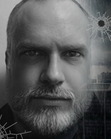Timothy James Lambert's Blog
December 3, 2016
The Gurdjieffian Roots of Leary's Eight-Circuit Model of Consciousness
An examination of the correspondences between Gurdjieff's centers and Leary's Eight-Circuit Model of Consciousness
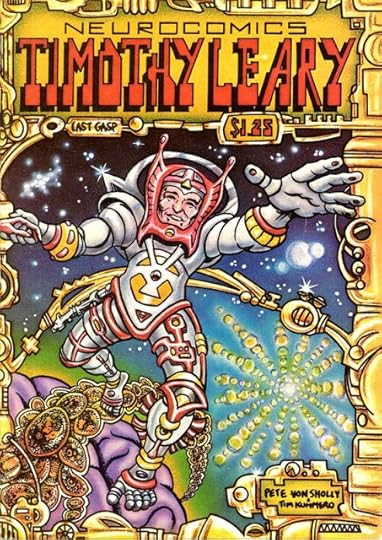
In this time of Chaos Magick, it pays to seek out concepts that can serve as points of stability in the new sea of flux. The eight-circuit model of consciousness was drawn up by Timothy Leary and then popularized by Robert Anton Wilson, but its roots are found in the works of the mystic Gurdjieff as reported by his student Ouspensky in the book In Search of the Miraculous.Gurdjieff divided his system into two levels, the Lower Centers and the Higher Centers. Notice however that this division is not identical to that of Leary's Terrestrial and Extra-Terrestrial Circuitry.Lower centers:The first of these centers is the Instinctive center which controls involuntary processes. In medical terminology, this is the autonomic nervous system.The next is the Moving center which consists of those learned physical processes whose mechanisms have become subconscious, such as walking, eating, driving, etc.Next is the Sexual center. This controls sexual function but it is also the source of the imagination.Then we have the Lower Emotional center.The final lower center is the Lower Intellectual center.Higher centers:The Higher Emotional center. It allows one to experience states of self-consciousness, self-awareness, and other deep feelings.The Higher Intellectual center. It allows one to experience states of objective consciousness and superior intellect.So let's see how these match up to Leary's system.The bio-survival circuit, with its possibility of moving towards pleasant stimuli and away from unpleasant stimuli, seems to be a good match for the Moving center.The muscular-political circuit, with its direction of up for domination and down for submission, likely corresponds to the Lower Emotional center.The symbolic-laryngeal circuit matches the Lower Intellectual center.The socio-sexual circuit is probably identical to the Higher Emotional center.The artistic-pleasure circuit would seem to go with the Sexual-Imagination center, which Gurdjieff claimed functioned as a higher center when accessed in the proper manner.The meta-intelligence circuit is undoubtedly the same as the Higher Intellectual center.Finally, we are left with the Instinctive center and the genetic-consciousness circuit, which don't seem to be identical so much as lower and higher octaves of a single aspect of existence. It is as though the Gurdjieff sequence runs Do Re Mi Fa So La Si, while the Leary sequence runs Re Mi Fa So La Si Do.The next circuit is the quantum consciousness circuit which doesn't have a corresponding center as Gurdjieff's system had only seven centers, still, much like the previous circuit, it can be seen as related to the circuit/system one octave lower, which is the bio-survival circuit /Moving center. The lower center/circuit is concerned with keeping the body alive, the higher circuit/center is concerned with expanding consciousness beyond the physical limits of time and space. So, once again, while the Gurdjieff sequence runs Do Re Mi Fa So La Si, the Leary sequence is one note longer and is offset by one, running Re Mi Fa So La Si Do Re.

In this time of Chaos Magick, it pays to seek out concepts that can serve as points of stability in the new sea of flux. The eight-circuit model of consciousness was drawn up by Timothy Leary and then popularized by Robert Anton Wilson, but its roots are found in the works of the mystic Gurdjieff as reported by his student Ouspensky in the book In Search of the Miraculous.Gurdjieff divided his system into two levels, the Lower Centers and the Higher Centers. Notice however that this division is not identical to that of Leary's Terrestrial and Extra-Terrestrial Circuitry.Lower centers:The first of these centers is the Instinctive center which controls involuntary processes. In medical terminology, this is the autonomic nervous system.The next is the Moving center which consists of those learned physical processes whose mechanisms have become subconscious, such as walking, eating, driving, etc.Next is the Sexual center. This controls sexual function but it is also the source of the imagination.Then we have the Lower Emotional center.The final lower center is the Lower Intellectual center.Higher centers:The Higher Emotional center. It allows one to experience states of self-consciousness, self-awareness, and other deep feelings.The Higher Intellectual center. It allows one to experience states of objective consciousness and superior intellect.So let's see how these match up to Leary's system.The bio-survival circuit, with its possibility of moving towards pleasant stimuli and away from unpleasant stimuli, seems to be a good match for the Moving center.The muscular-political circuit, with its direction of up for domination and down for submission, likely corresponds to the Lower Emotional center.The symbolic-laryngeal circuit matches the Lower Intellectual center.The socio-sexual circuit is probably identical to the Higher Emotional center.The artistic-pleasure circuit would seem to go with the Sexual-Imagination center, which Gurdjieff claimed functioned as a higher center when accessed in the proper manner.The meta-intelligence circuit is undoubtedly the same as the Higher Intellectual center.Finally, we are left with the Instinctive center and the genetic-consciousness circuit, which don't seem to be identical so much as lower and higher octaves of a single aspect of existence. It is as though the Gurdjieff sequence runs Do Re Mi Fa So La Si, while the Leary sequence runs Re Mi Fa So La Si Do.The next circuit is the quantum consciousness circuit which doesn't have a corresponding center as Gurdjieff's system had only seven centers, still, much like the previous circuit, it can be seen as related to the circuit/system one octave lower, which is the bio-survival circuit /Moving center. The lower center/circuit is concerned with keeping the body alive, the higher circuit/center is concerned with expanding consciousness beyond the physical limits of time and space. So, once again, while the Gurdjieff sequence runs Do Re Mi Fa So La Si, the Leary sequence is one note longer and is offset by one, running Re Mi Fa So La Si Do Re.
Published on December 03, 2016 04:03
Understanding Life Under Cthulhu
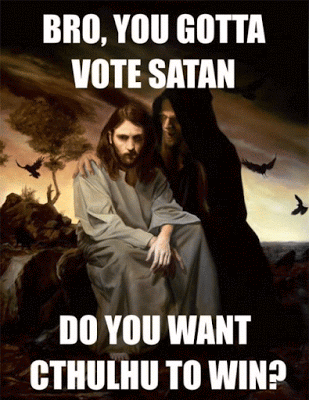
The event depicted in the meme has come to pass as the forces of Satan were vanquished by an even worse deity, Cthulhu.In the last election in the U.S. the choice was clear, Satan on the Left or Cthulhu on the Right. Satan stood for business as usual while Cthulhu represented the unleashing of the Kraken, releasing a force of pure chaos that sees humanity, if it perceives us at all, as an inconsequential form of life beneath consideration, except perhaps as a source of grease for lubricating the gears of time.Such a comparison seems overly melodramatic and lacking in any real world significance, but there is more to this matter than is apparent at first glance. Behind the Trump campaign was the mysterious Alt-Right movement whose member utilised both the symbolism and technology of Chaos Magick.Aleister Crowley is seen by many as the father of Chaos Magick. Consider his warning at the opening of his book Magick in Theory and Practice:
“In this book it is spoken of the Sephiroth and the Paths; of Spirits and Conjurations; of Gods, Spheres, Planes, and many other things which may or may not exist. It is immaterial whether these exist or not. By doing certain things certain results will follow; students are most earnestly warned against attributing objective reality or philosophic validity to any of them.” ― Aleister Crowley, Magick in Theory and PracticeCrowley was of the opinion that it wasn't the actual rituals that had true magickal power, rather it was the excited neural state of the participant that mattered. Still, he worked within the symbolic framework as reconstructed within the ceremonial rituals of the Golden Dawn with their mixture of Egyptian, Hermetic, and Renaissance traditions.In Chaos Magick there is no longer any need to be tied to any single traditional magickal system. All that matters is the resulting neural state.
Chaos Magick SigilThe man forever linking Crowley with Chaos Magick was Kenneth Grant, who drew a connection between Thelma, the magickal system developed by Crowley, and the works of horror writer H.P. Lovecraft.While Crowley was busy managing orgies slash developing rituals for contacting entities from other dimensions, Lovecraft was writing tales in which he described beings from other dimensions straining at the gates between the worlds, gates sealed aeons long past, but by seals weakened through age and the clumsy fumblings of the deluded worshippers of Cthulhu, forever foolishly intoning the syllables of some forgotten language.
https://cz.pinterest.com/karguello85/... used the fact that Lovecraft publically acknowledged drawing inspiration for his stories from his dreams as evidence that both Lovecraft and Crowley were using material from a realm which he called the Mauve Zone.
The dream is all we may know, normally, of the fourth dimension while we are embodied three-dimensionally. But we are not so embodied while dreaming. We are then already a step ahead, even although we are still viewing the scene from another dimension, an inner dimension, which differs from dreamless sleep in that it is not totally formless and void. This extra dimension is the Mauve Zone. Surrealists, futurists, cubists, abstractionists, were groping towards its expression.
Kenneth Grant in Outer GatewaysOnce you open up the system to Cthulhu, then why bother with the old "legacy" magick of the Golden Dawn with its mixture of Egyptian, Hermetic, and Renaissance tradition? Why not import any system you want? Why not Pepe the frog?
Chaos Magick is based on the idea that all is relative. All Truth is relative and whatever values exists are those which we ourselves have assigned. There can be no absolute truth because to know that, we would have to step outside of the system and since we can't, all truth is relative and arbitrary.This leads to both a magickal system employing symbolism from the Illuminati card game and a now President-elect, then Presidential Candidate, having the following discussion with MSNBC's Chris Matthews:
MATTHEWS: Well, why would you — why wouldn’t you just say, “I don’t want to talk about it. I don’t want to talk about nuclear weapons. Presidents don’t talk about use of nuclear weapons”?
TRUMP: The question was asked — we were talking about NATO — which, by the way, I say is obsolete and we pay a dis —
MATTHEWS: But you got hooked into something you shouldn`t have talked about.
TRUMP: I don’t think I — well, someday, maybe.
MATTHEWS: When? Maybe?
TRUMP: Of course. If somebody —
MATTHEWS: Where would we drop — where would we drop a nuclear weapon in the Middle East?
TRUMP: Let me explain. Let me explain. Somebody hits us within ISIS — you wouldn`t fight back with a nuke? …
MATTHEWS: OK. The trouble is, when you said that, the whole world heard it. David Cameron in Britain heard it. The Japanese, where we bombed them in 45, heard it. They`re hearing a guy running for president of the United States talking of maybe using nuclear weapons. Nobody wants to hear that about an American president.
TRUMP: Then why are we making them? Why do we make them?
[MSNBC, March 30, 2016]Here we have the Cthulhu candidate talking about the use of nuclear weapons, an idea which, since the creation of the MAD or mutually assured destruction doctrine, has been literally unthinkable. The spectre of nuclear war had long since been banished. Only Chaos means there are no unthinkables, there is nothing its agents won't bring to the table in their battle for domination. Cue Putin's unveiling of Russia's new uber-missile, Satan II.The same with dog-whistle politics. According to Wikipedia, dog-whistle politics is political messaging employing coded language that appears to mean one thing to the general population but has an additional, different or more specific resonance for a targeted subgroup.The reason they employ such silent dog-whistles is they are afraid to communicate their typically racist messages overtly because the general audience would likely take notice which would cause unpredictable future outcomes with potentially negative repercussions. Cthulhu thrives in chaos, so there's no need anymore for dog whistles, just say what you want and slap a swastika on the end of it. It's all good.The acolytes of Cthulhu also managed to undermine confidence in the media which projected a major win for team Satan. There are no more names you can trust. All is in flux.And yet, there is hope. Even within the chaos, there are patterns that repeat, relationships that form in spite of the relativists and their denials.For a deeper examination of these hidden patterns and their significance you might consult The Gnostic Notebook: On Plato, the Fourth Dimension, and the Lost Philosophy.
Published on December 03, 2016 03:59
November 6, 2016
Crowley, Leary, and our Collapsing Reality Tunnel
From Crowley heralding the Age of the Child, to Leary defining extra-terrestrial brain circuitry, both ultimately served the purposes of Corporate Fascism.
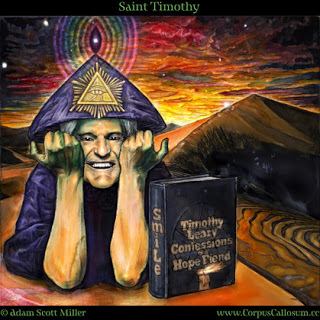 Old Aleister, with his Book of the Law, the whole of the Law being to do what thou will. Crowley taught that there were three Aeons. The first had been the Aeon of Isis, which was the time of goddess worship. Then came the Aeon of Osiris when the paternalistic religions of Christianity, Islam, and Buddhism ruled the world. He saw the present time as the dawning of the Aeon of Horus when humanity must take charge of its destiny. Isis was the age of the Mother, Osiris of the father, and Horus the Child.
Old Aleister, with his Book of the Law, the whole of the Law being to do what thou will. Crowley taught that there were three Aeons. The first had been the Aeon of Isis, which was the time of goddess worship. Then came the Aeon of Osiris when the paternalistic religions of Christianity, Islam, and Buddhism ruled the world. He saw the present time as the dawning of the Aeon of Horus when humanity must take charge of its destiny. Isis was the age of the Mother, Osiris of the father, and Horus the Child.
I was always a fan of Crowley, and of the sixties' countercultural heroes associated with him such as Timothy Leary and Robert Anton Wilson. So you can imagine my feelings of cognitive dissonance while reading Chris Hedges' brilliant examination of the historical choices that led to The Death of the Liberal Class (2010) as I came across the following:
The new ethic of the liberal class, Cowley wrote, was one that embraced “the idea of salvation by the child,” which proposed a new educational system “by which children are encouraged to develop their own personalities, to blossom freely like flowers, then the world will be saved by this new, free generation.” It championed self-expression so that the individual can “realize his full individuality through creative work and beautiful living in beautiful surroundings.” It fostered the cult of paganism, the idea that “the body is a temple in which there is nothing unclean, a shrine to be adorned for the ritual of love.” It called for living for the moment, to “dwell in it intensely, even at the cost of future suffering.” It defied all forms of Puritanism and demanded that “every law, convention or rule of art that prevents self-expression or the full enjoyment of the moment should be shattered and abolished.” It supported female equality. It embraced the therapeutic culture, the belief that “if our individual repressions can be removed? by confessing them to a Freudian psychologist? then we can adjust ourselves to any situation, and be happy in it.” The environment no longer needed to be altered, and “that explains why most radicals who became converted to psychoanalysis or glands or Gurdjieff [a popular mystic] gradually abandoned their political activism.”
Cowley noted that self-expression and paganism, however, only encouraged a demand for new products, from furniture to beach pajamas. The call to live for the moment, he argued, led people impulsively to purchase consumer goods, from automobiles to radios. Female equality was used to double the consumption of products such as cigarettes. The restlessness and fondness for self-imposed exile, embraced by Bohemians, intellectuals and artists, gave an allure to foreign objects and turned exotic locations into tourist destinations. (The Death of the Liberal Class pg. 101-102.)
The idea of class struggle was forgotten in the West, as the external "terrestrial" world and its "brain circuits" were "tuned out" and the internal "extra-terrestrial" world and its "brain circuits" were "tuned in."
These extra-terrestrial levels were the somatic/body pleasure level, the meta-intelligence level where you create your own reality, the genetic level where you can experience your genetic past and future history, and the quantum level of consciousness where the conscious mind is free of the body. The old terrestrial levels were the bio-survival level, the bio-political level, the laryngeal/symbolic level, and the social/sexual level.
So rather than fighting against the growing danger of corporate fascism we "tuned in, turned on, and dropped out." We learned how to experience bliss and pleasures beyond our parents' comprehension.
The quantum mechanics many worlds interpretation was often connected with the meta-intelligence level of consciousness. So there was this idea that you could "change your reality tunnel" like changing channels on a TV. And now I read this:
I WAS A CIA WHISTLEBLOWER. NOW I’M A BLACK INMATE. HERE’S HOW I SEE AMERICAN RACISM.
The link above leads to a story about TV's, reality tunnels, and prison. The message I take from it is that maybe we should pull back a bit from the creating our own reality level of consciousness.
 Old Aleister, with his Book of the Law, the whole of the Law being to do what thou will. Crowley taught that there were three Aeons. The first had been the Aeon of Isis, which was the time of goddess worship. Then came the Aeon of Osiris when the paternalistic religions of Christianity, Islam, and Buddhism ruled the world. He saw the present time as the dawning of the Aeon of Horus when humanity must take charge of its destiny. Isis was the age of the Mother, Osiris of the father, and Horus the Child.
Old Aleister, with his Book of the Law, the whole of the Law being to do what thou will. Crowley taught that there were three Aeons. The first had been the Aeon of Isis, which was the time of goddess worship. Then came the Aeon of Osiris when the paternalistic religions of Christianity, Islam, and Buddhism ruled the world. He saw the present time as the dawning of the Aeon of Horus when humanity must take charge of its destiny. Isis was the age of the Mother, Osiris of the father, and Horus the Child.I was always a fan of Crowley, and of the sixties' countercultural heroes associated with him such as Timothy Leary and Robert Anton Wilson. So you can imagine my feelings of cognitive dissonance while reading Chris Hedges' brilliant examination of the historical choices that led to The Death of the Liberal Class (2010) as I came across the following:
The new ethic of the liberal class, Cowley wrote, was one that embraced “the idea of salvation by the child,” which proposed a new educational system “by which children are encouraged to develop their own personalities, to blossom freely like flowers, then the world will be saved by this new, free generation.” It championed self-expression so that the individual can “realize his full individuality through creative work and beautiful living in beautiful surroundings.” It fostered the cult of paganism, the idea that “the body is a temple in which there is nothing unclean, a shrine to be adorned for the ritual of love.” It called for living for the moment, to “dwell in it intensely, even at the cost of future suffering.” It defied all forms of Puritanism and demanded that “every law, convention or rule of art that prevents self-expression or the full enjoyment of the moment should be shattered and abolished.” It supported female equality. It embraced the therapeutic culture, the belief that “if our individual repressions can be removed? by confessing them to a Freudian psychologist? then we can adjust ourselves to any situation, and be happy in it.” The environment no longer needed to be altered, and “that explains why most radicals who became converted to psychoanalysis or glands or Gurdjieff [a popular mystic] gradually abandoned their political activism.”
Cowley noted that self-expression and paganism, however, only encouraged a demand for new products, from furniture to beach pajamas. The call to live for the moment, he argued, led people impulsively to purchase consumer goods, from automobiles to radios. Female equality was used to double the consumption of products such as cigarettes. The restlessness and fondness for self-imposed exile, embraced by Bohemians, intellectuals and artists, gave an allure to foreign objects and turned exotic locations into tourist destinations. (The Death of the Liberal Class pg. 101-102.)
The idea of class struggle was forgotten in the West, as the external "terrestrial" world and its "brain circuits" were "tuned out" and the internal "extra-terrestrial" world and its "brain circuits" were "tuned in."
These extra-terrestrial levels were the somatic/body pleasure level, the meta-intelligence level where you create your own reality, the genetic level where you can experience your genetic past and future history, and the quantum level of consciousness where the conscious mind is free of the body. The old terrestrial levels were the bio-survival level, the bio-political level, the laryngeal/symbolic level, and the social/sexual level.
So rather than fighting against the growing danger of corporate fascism we "tuned in, turned on, and dropped out." We learned how to experience bliss and pleasures beyond our parents' comprehension.
The quantum mechanics many worlds interpretation was often connected with the meta-intelligence level of consciousness. So there was this idea that you could "change your reality tunnel" like changing channels on a TV. And now I read this:
I WAS A CIA WHISTLEBLOWER. NOW I’M A BLACK INMATE. HERE’S HOW I SEE AMERICAN RACISM.
The link above leads to a story about TV's, reality tunnels, and prison. The message I take from it is that maybe we should pull back a bit from the creating our own reality level of consciousness.
Published on November 06, 2016 18:24
October 7, 2016
New Review of The Gnostic Notebook: On Plato, the Fourth Dimension, and the Lost Philosophy
LibraryThing.com reviewer elenchus writes:This third entry in Lambert's Notebooks opens with an intriguing discussion of Dali's Crucifixion , and proceeds into a giddy survey of hypercubes, dimensionality, Cartesian coordinates, and Platonic solids ("speculative geometry"). Lambert then holds up for examination, over the next nine chapters and 140-odd pages, his speculations concerning an ancient system used to transmit sacred mysteries over time, intact and encrypted. Lambert posits a "conspiracy" in which Plato endeavoured to preserve while yet hiding these mysteries, a grand feat of steganography in that Plato's writings are widely considered important enough to preserve (by those ignorant of the mysteries), thereby enabling the encrypted content to survive undetected. [26, 38-41]
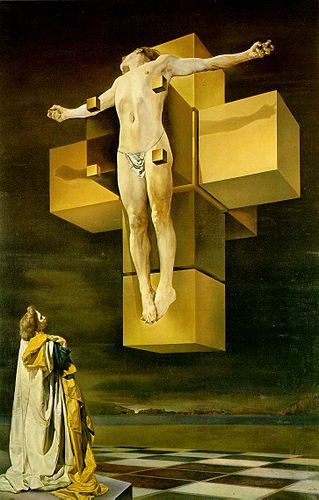 Dali's Crucifixion (Corpus Hypercubus)
Dali's Crucifixion (Corpus Hypercubus)
Note that Lambert examines in this volume, the hidden system for encryption , and not (with one exception discussed briefly below) the mysteries allegedly encrypted by application of this system.
Lambert's argument in this third notebook is vastly more ambitious than those of the previous notebooks, and that much more open to critique. My skepticism falls under two broad heads. First, it seems far less likely for a single system to employ multiple keys, yet be understood by a single group of people and be utilised for a single coherent purpose; than it is for the various texts examined (Gospel of Thomas, Creation Story in Genesis, Plato's Timaeus ) to have been encrypted by varying people, at different times and for varying purposes, mostly if not wholly ignorant of one another. (If in fact, any or some of these texts are encrypted at all, though on this count I'm less skeptical.) Second, Lambert's method is not verifiable in the manner that, for example, Reed's decryption of the Steganographia was verifiable. Here, no comparable messages are revealed which are self-evidently genuine. The closest candidate Lambert offers is the suggestion that the Genesis creation story can be read as an encrypted analogue of the current scientific account of biological evolution on Earth. Even this, though, is not verifiable: he does not uncover a literal and specific message, precisely what an encryption system is designed to transmit. Rather, Lambert argues one logical structure has been recast in terms of another structure, that an analogue is to be found.
The Gnostic Notebook
In view of all this, Lambert's notebooks continue to hold my attention insofar as they introduce fascinating concepts, uncover historical archives, track ideas he finds curious or interesting, and draw intriguing connections between ideas and interpretations I'm exceedingly unlikely to do on my own. I am persuaded that many of the parallels and connections Lambert makes are more than coincidence, that something is there. Lambert's notebooks are invaluable for these reasons, and their publication offers an opportunity to widen the conversation, precisely the rationale for a conceptual notebook.
// Keys examined: 1 - close packed spheres / structures (Democritus) 2 - tree of life / zodiacal sign / days of week 3 - Euclidean geometry / dimensions / Platonic solids 4 - Genesis creation myth / Evolutionary lifeforms (bacteria, etc) 5 - I Ching trigrams & hexagrams
Read the entire review at:https://www.librarything.com/work/17953753/reviews/131517178
 Dali's Crucifixion (Corpus Hypercubus)
Dali's Crucifixion (Corpus Hypercubus)Note that Lambert examines in this volume, the hidden system for encryption , and not (with one exception discussed briefly below) the mysteries allegedly encrypted by application of this system.
Lambert's argument in this third notebook is vastly more ambitious than those of the previous notebooks, and that much more open to critique. My skepticism falls under two broad heads. First, it seems far less likely for a single system to employ multiple keys, yet be understood by a single group of people and be utilised for a single coherent purpose; than it is for the various texts examined (Gospel of Thomas, Creation Story in Genesis, Plato's Timaeus ) to have been encrypted by varying people, at different times and for varying purposes, mostly if not wholly ignorant of one another. (If in fact, any or some of these texts are encrypted at all, though on this count I'm less skeptical.) Second, Lambert's method is not verifiable in the manner that, for example, Reed's decryption of the Steganographia was verifiable. Here, no comparable messages are revealed which are self-evidently genuine. The closest candidate Lambert offers is the suggestion that the Genesis creation story can be read as an encrypted analogue of the current scientific account of biological evolution on Earth. Even this, though, is not verifiable: he does not uncover a literal and specific message, precisely what an encryption system is designed to transmit. Rather, Lambert argues one logical structure has been recast in terms of another structure, that an analogue is to be found.
The Gnostic Notebook
In view of all this, Lambert's notebooks continue to hold my attention insofar as they introduce fascinating concepts, uncover historical archives, track ideas he finds curious or interesting, and draw intriguing connections between ideas and interpretations I'm exceedingly unlikely to do on my own. I am persuaded that many of the parallels and connections Lambert makes are more than coincidence, that something is there. Lambert's notebooks are invaluable for these reasons, and their publication offers an opportunity to widen the conversation, precisely the rationale for a conceptual notebook.
// Keys examined: 1 - close packed spheres / structures (Democritus) 2 - tree of life / zodiacal sign / days of week 3 - Euclidean geometry / dimensions / Platonic solids 4 - Genesis creation myth / Evolutionary lifeforms (bacteria, etc) 5 - I Ching trigrams & hexagrams
Read the entire review at:https://www.librarything.com/work/17953753/reviews/131517178
Published on October 07, 2016 09:15
September 15, 2016
The Impossibility of the Fourth Dimension
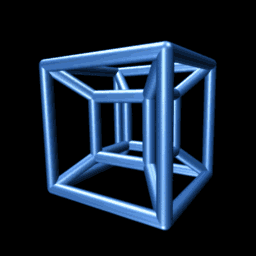 Tesseract rotating in the fourth dimension (Hise, 2006).The principle of 'The Unreasonable Effectiveness of Mathematics in the Natural Sciences' would seem to point to the reality of the Fourth Dimension. So why don't we perceive this Fourth Dimension?Let's talk for a moment about Newton's laws of motion. He managed to concoct a single mathematical description that explained two entirely different orders of phenomena: a planet orbiting its star and an apple falling from a tree.
Tesseract rotating in the fourth dimension (Hise, 2006).The principle of 'The Unreasonable Effectiveness of Mathematics in the Natural Sciences' would seem to point to the reality of the Fourth Dimension. So why don't we perceive this Fourth Dimension?Let's talk for a moment about Newton's laws of motion. He managed to concoct a single mathematical description that explained two entirely different orders of phenomena: a planet orbiting its star and an apple falling from a tree.In 1960, physicist Eugene Wigner wrote an article titled The Unreasonable Effectiveness of Mathematics in the Natural Sciences in which he remarked on the almost magical manner in which mathematics serves as the ideal language for formulating the laws of physics.
Beyond Newton's laws, another common example are Maxwell's equations, which provide the basis for classical electrodynamics, classical optics, and electric circuits. These serve as the foundation for all electrical, optical and radio technologies. "The enormous usefulness of mathematics in the natural sciences is something bordering on the mysterious and that there is no rational explanation for it," Wigner wrote.It seems that it was this same sort of awareness of the mystical nature of mathematics that inspired Plato to create his World of Forms.
In his paper, Wigner noted that a physical theory's mathematical structure frequently provides clues to further advances and can even lead to empirical predictions. Plato would love to hear that. Plato was the master of making predictions from theory though he never cared much for empirical confirmation.
The magic of mathematics is that it can be used to create laws which seem to exist in a reality somehow higher than that of the physical objective world.
Platonist Henry More was the first to use the term "Fourth Dimension" though he used it to refer to Plato's World of Forms and not a fourth spatial dimension. Still as we have seen, Plato is responsible for both the idea of alternate dimensions and that of a spatial dimension beyond the usual three.
It was 1637 when Descartes published his work on what would come to be known as the Cartesian Coordinate System. This system merged geometry with algebra and led to the development of calculus.
On one hand, people were fascinated by the correspondence between the three dimensions of physical objective reality and the way they were so perfectly captured by the cubic cells of the Cartesian Coordinate System. On the other hand, mathematicians were making calculations in four dimensions. These calculations are conducted in four-dimensional Euclidean Space. These facts, taken together, seemed to indicate that there must be a spatial fourth dimension somewhere beyond our ability to perceive.
In 1827, as I noted in The Gnostic Notebook: On Plato, The Fourth Dimension and the Lost Philosophy, August Ferdinand Moebius wrote: "… two equal and similar solid figures, which are however mirror images of each other, could be made to coincide if one were 'able to let one system make a half revolution in a space of four dimensions. But since such a space cannot be conceived, this coincidence is impossible in this case."Moebus had already taken the first few steps into the Fourth Dimension. In 1880, W.I. Stringham’s published an article titled, "Regular Figures in N-dimensional Space", in the American Journal of Mathematics. In this article he included sketches of various higher dimensional shapes, including the tesseract.
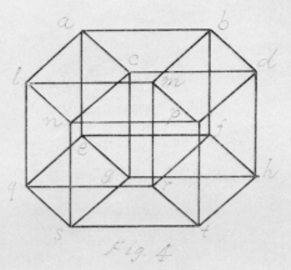 First published diagram of a hypercube (Stringham, 1880, Plate I).
First published diagram of a hypercube (Stringham, 1880, Plate I).Even though we cannot perceive the Fourth Dimension, we can formulate mathematical rules to determine what features these higher dimensional shapes possess.
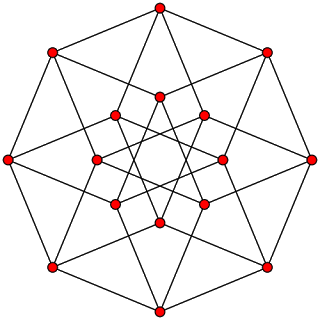 Orthographic projection of hypercube (Ruen, 2010).
Orthographic projection of hypercube (Ruen, 2010).For instance, as the next diagram makes clear, we begin with a single point at the zero-dimensional level. At the one-dimensional level we have a line, but more importantly we have doubled the number of points to two. At the two-dimensional stage we again have a doubling of points from two to four with the square. This doubling continues with the square's four points becoming the cube's eight points. Finally we arrive at the Fourth Dimension, the level of the hypercube or the tesseract, which no one has ever actually seen, yet we can determine from our mathematical progression that this figure will have double the number of points when compared to the cube.
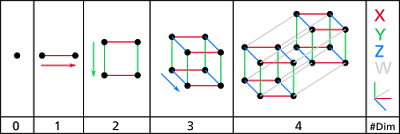 Dimension levels (NerdBoy1392, 2008).
Dimension levels (NerdBoy1392, 2008).There is also the mathematical equation known as Euler's Formula. This formula, when applied to four-dimensional shapes, is V - E + F - C = 0 where V = number of vertices, E = number of edges, F = number of faces, and C = number of (3-dimensional) cells.Let's look at the hypercube:Vertices are points, so V = 16. Edges are lines. A cube has 12 lines, two cubes have 24 lines and then there are 8 additional lines connecting the two cubes, so E = 32. Faces are planes. These are easier to see if we render the hypercube in the following manner:
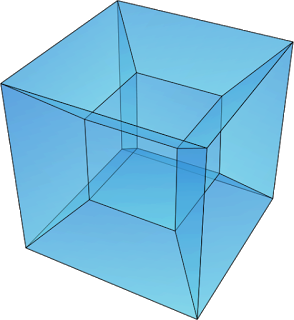 Hypercube (Mouagip, 2010).The outer cube has 6 faces, the inner cube has 6 faces and connecting these two cubes are 12 additional faces. So F = 24. Finally we come to the value of C which is the number of three-dimensional cells. There is the cell at the center and the cell of the larger cube giving us 2 and then there are cells between each of the two cubes' faces, making 6 cells, so C=8.V - E + F - C = 0 or16 - 32 + 24 - 8 = 0The math works out. Does this mean that a fourth spatial dimension actually exists? Henri Poincaré wrote in his The Value of Science (1907) :
Hypercube (Mouagip, 2010).The outer cube has 6 faces, the inner cube has 6 faces and connecting these two cubes are 12 additional faces. So F = 24. Finally we come to the value of C which is the number of three-dimensional cells. There is the cell at the center and the cell of the larger cube giving us 2 and then there are cells between each of the two cubes' faces, making 6 cells, so C=8.V - E + F - C = 0 or16 - 32 + 24 - 8 = 0The math works out. Does this mean that a fourth spatial dimension actually exists? Henri Poincaré wrote in his The Value of Science (1907) :“… experience does not prove to us that space has three dimensions; it only proves to us that it is convenient to attribute three to it.”And in his Science and Hypothesis (1905) he suggested:
“A person who should devote his existence to it might perhaps attain to a realization of the fourth dimension.”This opened the door to any and all who wished to theorize, promote, or attempt to reach the Fourth Dimension. Early Cubists, Surrealists, Futurists, and abstract artists took ideas from higher-dimensional mathematics as did charlatans, psychics, mystics, and spiritualists.
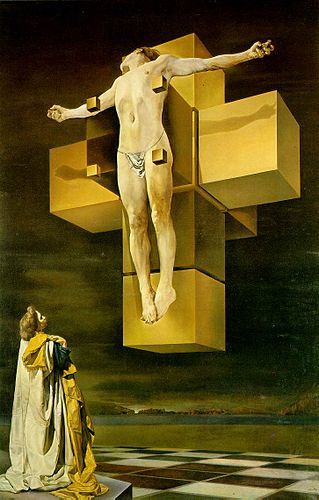 Salvador Dali's 1954 Crucifixion (Corpus Hypercubus).
Salvador Dali's 1954 Crucifixion (Corpus Hypercubus).In 1875, astrophysicist Johann Karl Friedrich Zöllner became interested in Fourth Dimension after being exposed to Spiritualism. With the assistance of the medium Henry Slade, Zöllner set up a series of seance experiments which included the interlinking of two wooden rings, slate-writing, tying knots on string, and retrieving coins from sealed boxes. He eventually came to the conclusion that the spirits were able to accomplish these feats because they are four-dimensional entities. Later, it turned out that the medium Henry Slade was actually a talented fraudster who had deceived Zöllner. No matter, the idea that spirits existed within the Fourth Dimension was accepted as fact by a gullible public."The Unreasonable Effectiveness of Mathematics in the Natural Sciences" principle would seem to point to the reality of the Fourth Dimension. Note however that this principle doesn't say that all mathematical formulations mirror actual physical relationships. Rather it says that those mathematical formulations which do mirror actual physical relationships seem to do so too perfectly.But, even as the hypercube and the Fourth Dimension were growing in popularity within the public imagination, another mathematical based theory of dimensions was rising in importance. In this theory, however, the fourth dimension was not a spatial dimension but was rather the dimension of time and this space-time was not found in four-dimensional Euclidean space but rather in non-Euclidean Minkowski space.
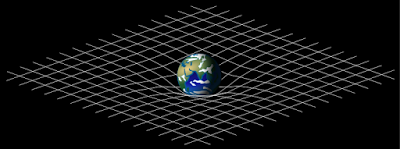 Deformation of spacetime caused by a planetary mass (Mysid, 2015).
Deformation of spacetime caused by a planetary mass (Mysid, 2015).It was this version of the Fourth Dimension with its dimpled rubber sheet of space-time that won out over the idea of a fourth spatial dimension. Let's not forget that the failed idea of a fourth physical dimension leads all the way back to Plato. It is a result of theorising from logic and theory without concern for empirical confirmation. Though the idea of a fourth spatial dimension was superseded by the reality of space-time, the ideas of parallel dimensions and higher dimensional realities continued to fester within the underground, only to have reemerged within the public's consciousness during the last few years.In my next post, we will examine two strands of this underground belief system that have somehow grown together and become stronger during their years within the shadowy realms of the public's unconscious mind: the ceremonial magick system devised by Aleister Crowley and the Cthulhu Mythos of H. P. Lovecraft.
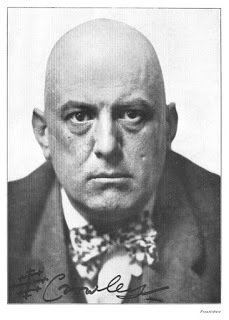 Aleister Crowley 1912
Aleister Crowley 1912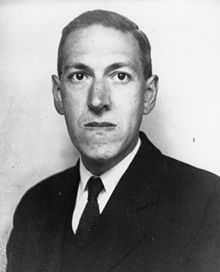
H. P. Lovecraft 1934
Published on September 15, 2016 00:00
September 9, 2016
Plato, the Father of the Fourth Dimension
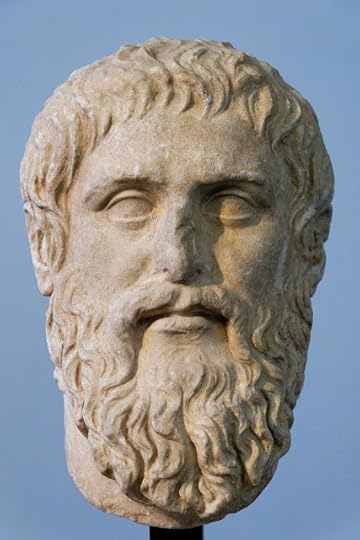 Plato. Luni marble, copy of the portrait made by Silanion ca. 370 BC for the Academia in Athens.Plato was the father of both Alternate Dimensions and the Fourth Dimension. The otherworldly nature of these two binds them together like the single side of a Moebius Strip.Readers of my book,
The Gnostic Notebook: On Plato, the Fourth Dimension, and the Lost Philosophy
, will recall the various connections between the works of Plato and the 'discovery' of the Fourth Dimension. These connections include the Analogy of the Cave with its depiction of prisoners entranced by the shadows cast on their cave wall. The prisoners mistake the shadows for the real three-dimensional world. In just this simple description we have two key techniques for the analyzing of higher dimensions: Projection, which is related to the casting of shadows, and Dimensional Analogy which is where we imagine how a two-dimensional being would experience a three-dimensional object as in Edwin Abbott Abbott's Flatland.
Plato. Luni marble, copy of the portrait made by Silanion ca. 370 BC for the Academia in Athens.Plato was the father of both Alternate Dimensions and the Fourth Dimension. The otherworldly nature of these two binds them together like the single side of a Moebius Strip.Readers of my book,
The Gnostic Notebook: On Plato, the Fourth Dimension, and the Lost Philosophy
, will recall the various connections between the works of Plato and the 'discovery' of the Fourth Dimension. These connections include the Analogy of the Cave with its depiction of prisoners entranced by the shadows cast on their cave wall. The prisoners mistake the shadows for the real three-dimensional world. In just this simple description we have two key techniques for the analyzing of higher dimensions: Projection, which is related to the casting of shadows, and Dimensional Analogy which is where we imagine how a two-dimensional being would experience a three-dimensional object as in Edwin Abbott Abbott's Flatland.It was also Plato who, with the formation of his academy at Athens, set into motion the collection and development of mathematical and geometrical knowledge which resulted in Euclid's Elements. This led, after a couple of thousand years, to the creation of the Cartesian coordinate system.
Plato was also the first to come up with the idea of an alternate dimension. He called his the World of Forms and identified it as a dimension filled with eternal and unchanging archetypes such as Truth, the perfect circle, the number 2, and the Pythagorean theorem.
The point of having the World of Forms is to be able to able to have a realm of absolutes outside of the material realm. That way one can recognize what is good because one has knowledge of the Good from the World of Forms and then one can find that which resembles the Good in the material realm.
This was all in an attempt to get to the essence of a thing. When we speak about something, we are using words to describe the thing. These words are themselves descriptions of aspects of the things, but how do we know that these other words correctly capture the essence of the aspects they describe? The deeper we go into examining the terms, the more obvious it becomes that these terms are just words used by those who came before us, none of which can bring us any closer to the thing's essence. Hence the need to jump out of the Universe to the realm of absolutes where the unchanging truth dwells.
Before Plato, the entire concept of a separate alternate dimension didn't exist. God was on top of a mountain, Hades was beneath the earth.
After Plato came the Christian heaven and hell, realms of eternal bliss or eternal suffering. Eternal because they exist outside of the material realm and therefore outside of time and space.
It seems as though these three aspects of Plato's philosophy: the dimensional aspects of the Analogy of the Cave, the alternate dimension of the World of Forms, and his support of research in mathematics and geometry which culminated in Euclid's Elements, apparently led to both the 'discovery' of the Fourth Dimension and the proliferation of alternate dimensions.
Moreover, the concepts of the Fourth Dimension and Parallel Dimensions are closely intertwined. We live in a space of three dimensions. Up - Down, Left - Right, and Forward - Back. Just like the citizen of Flatland who cannot perceive the Up - Down dimension, it may be that there is a hidden fourth perpendicular along which we can move. If so, that may mean that these parallel dimensions are quite close to our own when we move along this fourth dimension, though they remain unreachable from the usual three.
Using this sort of reasoning, it soon becomes obvious that Heaven and Hell must exist within the Fourth Dimension. As to the existence of the Fourth Dimension itself, we will consider that impossibility in the next post.
Published on September 09, 2016 00:39
August 31, 2016
Dimensions Beyond the Usual Three
The idea of parallel Universes and additional hidden spatial dimensions is a common feature in pop culture as well as in areas of scientific research such as quantum mechanics and Superstring Theory, but is there any actual empirical data supporting their existence?The concept of dimensions beyond the usual three pervades our culture. In a recent episode of the Netflix series, Stranger Things, the following exchange takes place at a funeral home after one of the main characters has apparently been put to rest:
 Mike, Lucas, and Justin question Mr. Clarke at Will's wake.Mike: So, you know how in Cosmos, Carl Sagan talks about other dimensions? Like, beyond our world?Mr. Clarke: Yeah, sure. Theoretically.Mike: Right, theoretically. Lucas: So, theoretically, how do we travel there? Mr. Clarke: You guys have been thinking about Hugh Everett's Many-Worlds Interpretation, haven' you? Well, basically, there are parallel universes. Just like our world, but just infinite variations of it. Which means there's a world out there where none of this tragic stuff ever happened. Lucas: Yeah, that's not what we're talking about. Mr. Clarke: Oh.Dustin: We were thinking of more of an evil dimension, like the Vale of Shadows. You know the Vale of Shadows? Mr. Clarke: An echo of the Material Plane, where necrotic and shadow magic...Mike: Yeah, exactly. If that did exist, a place like the Vale of Shadows, how would we travel there?Lucas: Theoretically.
Mike, Lucas, and Justin question Mr. Clarke at Will's wake.Mike: So, you know how in Cosmos, Carl Sagan talks about other dimensions? Like, beyond our world?Mr. Clarke: Yeah, sure. Theoretically.Mike: Right, theoretically. Lucas: So, theoretically, how do we travel there? Mr. Clarke: You guys have been thinking about Hugh Everett's Many-Worlds Interpretation, haven' you? Well, basically, there are parallel universes. Just like our world, but just infinite variations of it. Which means there's a world out there where none of this tragic stuff ever happened. Lucas: Yeah, that's not what we're talking about. Mr. Clarke: Oh.Dustin: We were thinking of more of an evil dimension, like the Vale of Shadows. You know the Vale of Shadows? Mr. Clarke: An echo of the Material Plane, where necrotic and shadow magic...Mike: Yeah, exactly. If that did exist, a place like the Vale of Shadows, how would we travel there?Lucas: Theoretically.
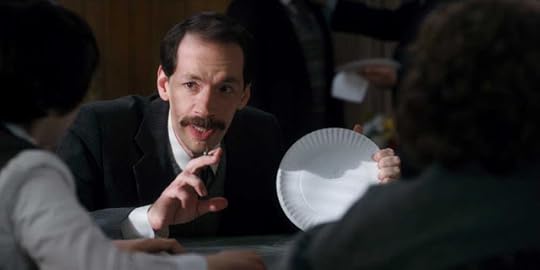 Mr. Clarke explaining the Acrobat and the Flea.Mr. Clarke: Well... Picture an acrobat standing on a tightrope. Now, the tightrope is our dimension. And our dimension has rules. You can move forwards, or backwards. But, what if right next to our acrobat, there is a flea? Now, the flea can also travel back and forth, just like the acrobat. Right? Mike: Right.Mr. Clarke: Here's where things get really interesting. The flea can also travel this way along the side of the rope. He can even go underneath the rope.Boys: Upside down.Mr. Clarke: Exactly.Mike: But we're not the flea, we're the acrobat. Mr. Clarke: In this metaphor, yes, we're the acrobat. Lucas: So we can't go upside down?Mr. Clarke: No.Dustin: Well, is there any way for the acrobat to get to the Upside Down?Mr. Clarke: Well you'd have to create a massive amount of energy. More than humans are currently capable of creating, mind you, to open up some kind of tear in time and space, and then you create a doorway. Dustin: Like a gate?Mr. Clarke: Sure. Like a gate. But again, this is all...Lucas: Theoretical.Mike: But, but what if this gate already existed? Mr. Clarke: Well, if it did, I, I think we'd know. It would disrupt gravity, the magnetic field, our environment. Heck, it might even swallow us up whole. In the scene above Mr. Clarke touches on two types of alternate dimensions. The first is Hugh Everett's Many-Worlds Interpretation, which, according to Wikipedia, states that "there is a very large—perhaps infinite—number of universes, and everything that could possibly have happened in our past, but did not, has occurred in the past of some other universe or universes."
Mr. Clarke explaining the Acrobat and the Flea.Mr. Clarke: Well... Picture an acrobat standing on a tightrope. Now, the tightrope is our dimension. And our dimension has rules. You can move forwards, or backwards. But, what if right next to our acrobat, there is a flea? Now, the flea can also travel back and forth, just like the acrobat. Right? Mike: Right.Mr. Clarke: Here's where things get really interesting. The flea can also travel this way along the side of the rope. He can even go underneath the rope.Boys: Upside down.Mr. Clarke: Exactly.Mike: But we're not the flea, we're the acrobat. Mr. Clarke: In this metaphor, yes, we're the acrobat. Lucas: So we can't go upside down?Mr. Clarke: No.Dustin: Well, is there any way for the acrobat to get to the Upside Down?Mr. Clarke: Well you'd have to create a massive amount of energy. More than humans are currently capable of creating, mind you, to open up some kind of tear in time and space, and then you create a doorway. Dustin: Like a gate?Mr. Clarke: Sure. Like a gate. But again, this is all...Lucas: Theoretical.Mike: But, but what if this gate already existed? Mr. Clarke: Well, if it did, I, I think we'd know. It would disrupt gravity, the magnetic field, our environment. Heck, it might even swallow us up whole. In the scene above Mr. Clarke touches on two types of alternate dimensions. The first is Hugh Everett's Many-Worlds Interpretation, which, according to Wikipedia, states that "there is a very large—perhaps infinite—number of universes, and everything that could possibly have happened in our past, but did not, has occurred in the past of some other universe or universes."
The second type discussed by the boys and Mr. Clarke are parallel planes of existence, and one in particular: "An evil dimension, like the Vale of Shadows," according to Dustin.
So we have two types of alternate dimensions. The first is a scientific theory, the second a commercialized mockery of an esoteric tradition, while the means to bind the two together within the narrative, the acrobat and the flea analogy, is a simplification of a single aspect of Superstring Theory. So there are actually three varieties of alternate dimensions being referenced in this single scene: Everett's Many-Worlds Interpretation, Esoteric Planes of Existence, and finally Superstring Theory, which itself requires a total of ten dimensions of space-time.
Let's see what the skeptics say concerning just the scientific extra-dimensional theories:
"For a start, how is the existence of the other universes to be tested? To be sure, all cosmologists accept that there are some regions of the universe that lie beyond the reach of our telescopes, but somewhere on the slippery slope between that and the idea that there are an infinite number of universes, credibility reaches a limit. As one slips down that slope, more and more must be accepted on faith, and less and less is open to scientific verification. Extreme multiverse explanations are therefore reminiscent of theological discussions. Indeed, invoking an infinity of unseen universes to explain the unusual features of the one we do see is just as ad hoc as invoking an unseen Creator. The multiverse theory may be dressed up in scientific language, but in essence it requires the same leap of faith." Paul Davies, A Brief History of the Multiverse
Concerning string theory, according to Wikipedia, theoretical physicist Lee Smolin, in his 2005 book The Trouble with Physics, "claims that string theory makes no new testable predictions; that it has no coherent mathematical formulation; and that it has not been mathematically proved finite." Also "string theory has yet to come up with a single prediction that can be verified using any technology that is likely to be feasible within our lifetimes."
If we write off Multi-World Theory as fantasy and Superstring research as being pure theory devoid of any empirical verification, that leaves us with just three dimensions of space and one of time, along with perhaps another four dimensions of momentum space, but most importantly with only the three observable dimensions of space. Finally we come to the other sort of alternate dimension which was discussed within the scene, that most persistent of delusions: the Parallel Plane of Existence, which in this instance is a realm labeled the Vale of Shadows or The Upside Down.
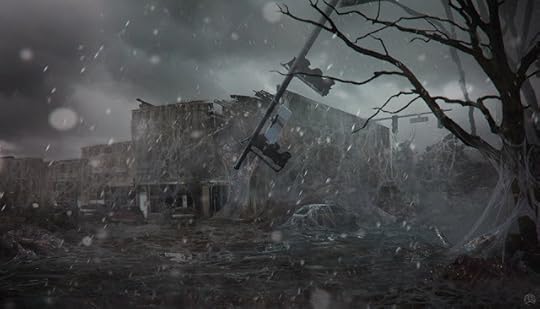 Concept art from Stranger Things.Readers of my book, The Gnostic Notebook: On Plato, The Fourth Dimension, and the Lost Philosophy will recognize Plato's World of Forms as both the archetypal prototype of and the dualistic opposite to "the Vale of Shadows, an echo of the Material Plane, where necrotic and shadow magic" stem.
Concept art from Stranger Things.Readers of my book, The Gnostic Notebook: On Plato, The Fourth Dimension, and the Lost Philosophy will recognize Plato's World of Forms as both the archetypal prototype of and the dualistic opposite to "the Vale of Shadows, an echo of the Material Plane, where necrotic and shadow magic" stem.
In my next post, we will delve further into the nature of these esoteric parallel planes of existence.
 Mike, Lucas, and Justin question Mr. Clarke at Will's wake.Mike: So, you know how in Cosmos, Carl Sagan talks about other dimensions? Like, beyond our world?Mr. Clarke: Yeah, sure. Theoretically.Mike: Right, theoretically. Lucas: So, theoretically, how do we travel there? Mr. Clarke: You guys have been thinking about Hugh Everett's Many-Worlds Interpretation, haven' you? Well, basically, there are parallel universes. Just like our world, but just infinite variations of it. Which means there's a world out there where none of this tragic stuff ever happened. Lucas: Yeah, that's not what we're talking about. Mr. Clarke: Oh.Dustin: We were thinking of more of an evil dimension, like the Vale of Shadows. You know the Vale of Shadows? Mr. Clarke: An echo of the Material Plane, where necrotic and shadow magic...Mike: Yeah, exactly. If that did exist, a place like the Vale of Shadows, how would we travel there?Lucas: Theoretically.
Mike, Lucas, and Justin question Mr. Clarke at Will's wake.Mike: So, you know how in Cosmos, Carl Sagan talks about other dimensions? Like, beyond our world?Mr. Clarke: Yeah, sure. Theoretically.Mike: Right, theoretically. Lucas: So, theoretically, how do we travel there? Mr. Clarke: You guys have been thinking about Hugh Everett's Many-Worlds Interpretation, haven' you? Well, basically, there are parallel universes. Just like our world, but just infinite variations of it. Which means there's a world out there where none of this tragic stuff ever happened. Lucas: Yeah, that's not what we're talking about. Mr. Clarke: Oh.Dustin: We were thinking of more of an evil dimension, like the Vale of Shadows. You know the Vale of Shadows? Mr. Clarke: An echo of the Material Plane, where necrotic and shadow magic...Mike: Yeah, exactly. If that did exist, a place like the Vale of Shadows, how would we travel there?Lucas: Theoretically.
 Mr. Clarke explaining the Acrobat and the Flea.Mr. Clarke: Well... Picture an acrobat standing on a tightrope. Now, the tightrope is our dimension. And our dimension has rules. You can move forwards, or backwards. But, what if right next to our acrobat, there is a flea? Now, the flea can also travel back and forth, just like the acrobat. Right? Mike: Right.Mr. Clarke: Here's where things get really interesting. The flea can also travel this way along the side of the rope. He can even go underneath the rope.Boys: Upside down.Mr. Clarke: Exactly.Mike: But we're not the flea, we're the acrobat. Mr. Clarke: In this metaphor, yes, we're the acrobat. Lucas: So we can't go upside down?Mr. Clarke: No.Dustin: Well, is there any way for the acrobat to get to the Upside Down?Mr. Clarke: Well you'd have to create a massive amount of energy. More than humans are currently capable of creating, mind you, to open up some kind of tear in time and space, and then you create a doorway. Dustin: Like a gate?Mr. Clarke: Sure. Like a gate. But again, this is all...Lucas: Theoretical.Mike: But, but what if this gate already existed? Mr. Clarke: Well, if it did, I, I think we'd know. It would disrupt gravity, the magnetic field, our environment. Heck, it might even swallow us up whole. In the scene above Mr. Clarke touches on two types of alternate dimensions. The first is Hugh Everett's Many-Worlds Interpretation, which, according to Wikipedia, states that "there is a very large—perhaps infinite—number of universes, and everything that could possibly have happened in our past, but did not, has occurred in the past of some other universe or universes."
Mr. Clarke explaining the Acrobat and the Flea.Mr. Clarke: Well... Picture an acrobat standing on a tightrope. Now, the tightrope is our dimension. And our dimension has rules. You can move forwards, or backwards. But, what if right next to our acrobat, there is a flea? Now, the flea can also travel back and forth, just like the acrobat. Right? Mike: Right.Mr. Clarke: Here's where things get really interesting. The flea can also travel this way along the side of the rope. He can even go underneath the rope.Boys: Upside down.Mr. Clarke: Exactly.Mike: But we're not the flea, we're the acrobat. Mr. Clarke: In this metaphor, yes, we're the acrobat. Lucas: So we can't go upside down?Mr. Clarke: No.Dustin: Well, is there any way for the acrobat to get to the Upside Down?Mr. Clarke: Well you'd have to create a massive amount of energy. More than humans are currently capable of creating, mind you, to open up some kind of tear in time and space, and then you create a doorway. Dustin: Like a gate?Mr. Clarke: Sure. Like a gate. But again, this is all...Lucas: Theoretical.Mike: But, but what if this gate already existed? Mr. Clarke: Well, if it did, I, I think we'd know. It would disrupt gravity, the magnetic field, our environment. Heck, it might even swallow us up whole. In the scene above Mr. Clarke touches on two types of alternate dimensions. The first is Hugh Everett's Many-Worlds Interpretation, which, according to Wikipedia, states that "there is a very large—perhaps infinite—number of universes, and everything that could possibly have happened in our past, but did not, has occurred in the past of some other universe or universes."The second type discussed by the boys and Mr. Clarke are parallel planes of existence, and one in particular: "An evil dimension, like the Vale of Shadows," according to Dustin.
So we have two types of alternate dimensions. The first is a scientific theory, the second a commercialized mockery of an esoteric tradition, while the means to bind the two together within the narrative, the acrobat and the flea analogy, is a simplification of a single aspect of Superstring Theory. So there are actually three varieties of alternate dimensions being referenced in this single scene: Everett's Many-Worlds Interpretation, Esoteric Planes of Existence, and finally Superstring Theory, which itself requires a total of ten dimensions of space-time.
Let's see what the skeptics say concerning just the scientific extra-dimensional theories:
"For a start, how is the existence of the other universes to be tested? To be sure, all cosmologists accept that there are some regions of the universe that lie beyond the reach of our telescopes, but somewhere on the slippery slope between that and the idea that there are an infinite number of universes, credibility reaches a limit. As one slips down that slope, more and more must be accepted on faith, and less and less is open to scientific verification. Extreme multiverse explanations are therefore reminiscent of theological discussions. Indeed, invoking an infinity of unseen universes to explain the unusual features of the one we do see is just as ad hoc as invoking an unseen Creator. The multiverse theory may be dressed up in scientific language, but in essence it requires the same leap of faith." Paul Davies, A Brief History of the Multiverse
Concerning string theory, according to Wikipedia, theoretical physicist Lee Smolin, in his 2005 book The Trouble with Physics, "claims that string theory makes no new testable predictions; that it has no coherent mathematical formulation; and that it has not been mathematically proved finite." Also "string theory has yet to come up with a single prediction that can be verified using any technology that is likely to be feasible within our lifetimes."
If we write off Multi-World Theory as fantasy and Superstring research as being pure theory devoid of any empirical verification, that leaves us with just three dimensions of space and one of time, along with perhaps another four dimensions of momentum space, but most importantly with only the three observable dimensions of space. Finally we come to the other sort of alternate dimension which was discussed within the scene, that most persistent of delusions: the Parallel Plane of Existence, which in this instance is a realm labeled the Vale of Shadows or The Upside Down.
 Concept art from Stranger Things.Readers of my book, The Gnostic Notebook: On Plato, The Fourth Dimension, and the Lost Philosophy will recognize Plato's World of Forms as both the archetypal prototype of and the dualistic opposite to "the Vale of Shadows, an echo of the Material Plane, where necrotic and shadow magic" stem.
Concept art from Stranger Things.Readers of my book, The Gnostic Notebook: On Plato, The Fourth Dimension, and the Lost Philosophy will recognize Plato's World of Forms as both the archetypal prototype of and the dualistic opposite to "the Vale of Shadows, an echo of the Material Plane, where necrotic and shadow magic" stem.In my next post, we will delve further into the nature of these esoteric parallel planes of existence.
Published on August 31, 2016 16:33
August 20, 2016
From the Mobius Strip to the Fourth Dimension
 A mannequin hand rotated in the fourth dimension a half-turn at a time (Lambert, 2016).In 1827, as I noted in Volume Three of The Gnostic Notebook: On Plato, The Fourth Dimension and the Lost Philosophy, August Ferdinand Möbius wrote, "… two equal and similar solid figures, which are however mirror images of each other, could be made to coincide if one were 'able to let one system make a half revolution in a space of four dimensions. But since such a space cannot be conceived, this coincidence is impossible in this case.'"
A mannequin hand rotated in the fourth dimension a half-turn at a time (Lambert, 2016).In 1827, as I noted in Volume Three of The Gnostic Notebook: On Plato, The Fourth Dimension and the Lost Philosophy, August Ferdinand Möbius wrote, "… two equal and similar solid figures, which are however mirror images of each other, could be made to coincide if one were 'able to let one system make a half revolution in a space of four dimensions. But since such a space cannot be conceived, this coincidence is impossible in this case.'"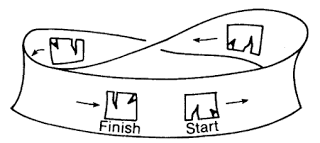 Movement along the Moebius Strip flips object to its mirror opposite (Rucker, 1974).
Movement along the Moebius Strip flips object to its mirror opposite (Rucker, 1974).To get a clearer picture of what exactly Moebius was getting at, we must return to his strip and consider what happens to a two-dimensional citizen of Flatland as he moves around the band. Still, to be absolutely precise, the Flatlander doesn't actually move along the surface of the strip, rather the strip is an invisible membrane through which the Flatlander flows. So he is not so much on the strip and present on one side or other of the piece of paper, as he is moving within the invisible membrane of the strip which to him is the entire Universe. Anyway, when this Flatlander finally makes his way around the strip he returns to the point where he began but now he is upside-down.
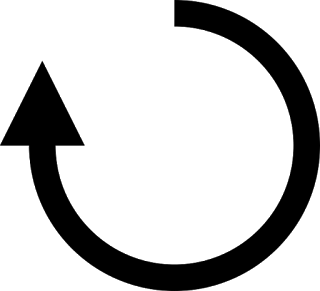 Rotation around the Z-axis.The state of being upside-down, while probably not even relevant to a Flatlander, can be easily rectified by rotation around the Z-axis. However, even after being returned to its upside-up position, it becomes obvious that the being's left- and right-sides have switched sides as well. However, the only forms of rotation it has available are clockwise or counter-clockwise rotation around the Z-axis. Rotation around either the X- or Y-axis would require the Flatlander to pull itself up off of the Moebius Strip which is an impossibility as the transparent membrane of the strip is the Flatlander's entire Universe.
Rotation around the Z-axis.The state of being upside-down, while probably not even relevant to a Flatlander, can be easily rectified by rotation around the Z-axis. However, even after being returned to its upside-up position, it becomes obvious that the being's left- and right-sides have switched sides as well. However, the only forms of rotation it has available are clockwise or counter-clockwise rotation around the Z-axis. Rotation around either the X- or Y-axis would require the Flatlander to pull itself up off of the Moebius Strip which is an impossibility as the transparent membrane of the strip is the Flatlander's entire Universe.So the one-half twist in the Moebius Strip allows the Flatlander to become his mirror opposite. This allows us to reason by analogy and take the entire process one dimension up. Instead of a two-dimensional Flatlander, we can imagine the unattached left hand of a shop mannequin. Here, in our three-dimensional world, it will always remain a left hand. However, if a four-dimensional being were to reach into our world and rotate the mannequin hand a single half-turn around the fourth dimension, we would see the left hand transformed into a right.
And yet, Buckminster Fuller would not be impressed. It all begins with reasoning by analogy. "Suppose you were a two-dimensional being, how would you perceive a three-dimensional being moving through your world?" This is generally how the higher dimensions are approached, and yet, all to often, the premises are never adequately examined, which is to say the fact that two-dimensional lifeforms do not exist is conveniently ignored. And why is it that two-dimensional creatures do not exist? For the simple reason that we exist in a material Universe made up of pieces of matter and not an idealized Universe made out of weightless, two-dimensional scales which explode and billow like leaves in the wind before reorganising themselves into the surface features of all that we perceive. After all, regardless of what we may have been taught, we are not actually trapped within a computer simulation.
In my next post, we will examine the various types of dimensions beyond the usual three.
Published on August 20, 2016 09:16
August 14, 2016
Buckminster Fuller on the Moebius Strip
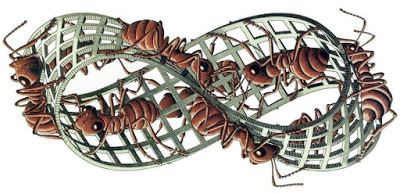 Möbius Strip II (Red Ants) M.C. Escher
Möbius Strip II (Red Ants) M.C. Escher What is a Moebius Strip?
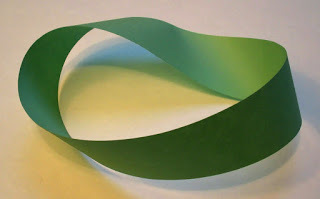 Möbius StripA Moebius Strip is a loop formed by taking a strip of paper and adhering the two ends together while twisting one of the ends a half turn.
Möbius StripA Moebius Strip is a loop formed by taking a strip of paper and adhering the two ends together while twisting one of the ends a half turn.This object has some rather unique properties. For instance, this loop has only one side. Imagine, every piece of paper has two sides, and yet, somehow, from a two-sided piece of paper an object possessing only one side is created.
Another unique feature of the Moebius Strip is that if you draw a line down its length from the center of the strip, you will have to go around the loop twice to return to your starting point. If you were to cut along this line you would end up with a single loop twice as long as the original with two full twists, rather than the original's half twist.
In his magnum opus Synergetics (1975), Buckminster Fuller had this to say about the Moebius Strip:
831.10 Moebius Strip
831.11 In the same operational piecrust-making strictness of observation, we realize that the phase of topology that Moebius employed in developing his famous strip mistakenly assumed that the strip of paper had two completely nonconnected faces of such thinness as to have no edge dimension whatsoever. When we study the Moebius strip of paper and the method of twisting one of its ends before fastening them together and scribing and cutting the central line of the strip only to find that it is still a single circle of twice the circumference and half the width of the strip, we realize that the strip was just a partially flattened section of our piecrust, which the baker would have produced by making a long hard roll, thinner than a breadstick and flattened out with his wooden roller. What Moebius really did was to take a flattened tube, twist one of its ends 180 degrees, and rejoin the tube ends to one another. The scribed line of cutting would simply be a spiral around the tube, which made it clear that the two alternate ends of the spirals were joined to one another before the knifing commenced.
What exactly is Fuller talking about in the above section of text? The point he is making is that the apparently amazing properties possessed by the Moebius Strip are the result of a semantic trick. Looking through the lens of Iain McGilchrist's The Master and His Emissary (2009), we can see this as an example of the left brain's tendency to be seduced by the idealised forms hidden behind the labels used to describe objects such as the Moebius Strip.
A sheet of paper is seen as a two-dimension plane, having only width and height. The same, naturally with a strip of paper. The strip of paper has two sides and four edges. When the two ends are joined with a half twist, the resulting object has one side and one edge. However, the left brain's method of understanding is to focus on individual features while ignoring the whole.
The right brain doesn't have such a good eye for individual details, rather it sees the whole picture as though it were fuzzy or a bit out of focus. So where the left brain sees a one-sided loop, the right brain sees a loop made from a flattened tube of dough. Topologically there should be no real difference between a strip of paper and a strip of dough unless we took the strip as being two-dimensional and having a depth of zero. Yet that is exactly what we how we have been trained to look at it.
Fuller also considers what happens when a line is drawn down the center of the Moebius Strip and cut along with scissors, only he sees it as a tube of dough around which a helix is cut, not a spiral as he wrote, and though it is a common enough error to confuse the two, it seems out of character for Fuller who is usually so precise.
Still, his point is valid. The magic possessed by a two-dimensional object with only one side seems much greater than that of a three-dimensional object whose contour is molded with a decorative half-twist. The first seems an impossibility, while the second is simply an interesting choice of design. The difference in perception is due to the nature of the edge; a razor sharp, one-dimensional edge isolates each side of the strip from its opposite, while an edge with some thickness helps the observer to recognize the true nature of the object as a flattened torus whose bodywork has been modified with a simple cosmetic half-twist.
All of this is related to the examination of the fourth dimension which I described in my book The Gnostic Notebook: On Plato, the Fourth Dimension, and the Lost Philosophy as it was August Ferdinand Moebius, the discoverer of the Moebius Strip, who was the first to work out the effects of rotation in four-dimensional space. Indeed the two subjects are closely bound as we'll see in the next post.
Published on August 14, 2016 12:49
July 20, 2016
"Gigantis Recruitment" or an Examination of the Life-Cycle of Giants as Found within the Tales of the Brothers Grimm
Recently I have been reading through the Grimms tales that dealt with giants. When I read these sorts of tales I am looking for various things. For instance, sometimes I trace the development of a story from version to version, as well as down different family lines as it were. But my primary focus is on those stories that seem to contain apparently identical scenes as seen from different perspectives.
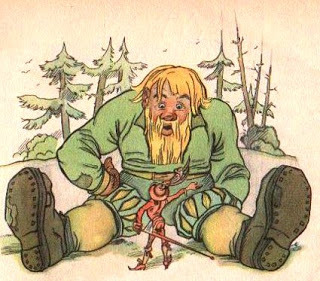 Let's look at the following beginning section from a tale: #193. The Drummer:A young drummer went out quite alone one evening into the country, and came to a lake on the shore of which he perceived three pieces of white linen lying. "What fine linen," said he, and put one piece in his pocket. He returned home, thought no more of what he had found, and went to bed. Just as he was going to sleep, it seemed to him as if some one was saying his name. He listened, and was aware of a soft voice which cried to him, "Drummer, drummer, wake up!" As it was a dark night he could see no one, but it appeared to him that a figure was hovering about his bed. "What do you want?" he asked. "Give me back my dress," answered the voice, "that you took away from me last evening by the lake." "You shall have it back again," said the drummer, "if you will tell me who you are." "Ah," replied the voice, "I am the daughter of a mighty King; but I have fallen into the power of a witch, and am shut up on the glass-mountain. I have to bathe in the lake every day with my two sisters, but I cannot fly back again without my dress. My sisters have gone away, but I have been forced to stay behind. I entreat you to give me my dress back." "Be easy, poor child," said the drummer. "I will willingly give it back to you." He took it out of his pocket, and reached it to her in the dark. She snatched it in haste, and wanted to go away with it. "Stop a moment, perhaps I can help you." "You can only help me by ascending the glass-mountain, and freeing me from the power of the witch. But you cannot come to the glass-mountain, and indeed if you were quite close to it you could not ascend it." "When I want to do a thing I always can do it," said the drummer; "I am sorry for you, and have no fear of anything. But I do not know the way which leads to the glass-mountain." "The road goes through the great forest, in which the man-eaters live," she answered, "and more than that, I dare not tell you." And then he heard her wings quiver, as she flew away. By daybreak the drummer arose, buckled on his drum, and went without fear straight into the forest. After he had walked for a while without seeing any giants, he thought to himself, "I must waken up the sluggards," and he hung his drum before him, and beat such a reveille that the birds flew out of the trees with loud cries. It was not long before a giant who had been lying sleeping among the grass, rose up, and was as tall as a fir-tree. "Wretch!" cried he; "what art thou drumming here for, and wakening me out of my best sleep?" "I am drumming," he replied, "because I want to show the way to many thousands who are following me." "What do they want in my forest?" demanded the giant. "They want to put an end to thee, and cleanse the forest of such a monster as thou art!" "Oho!" said the giant, "I will trample you all to death like so many ants." "Dost thou think thou canst do anything against us?" said the drummer; "if thou stoopest to take hold of one, he will jump away and hide himself ; but when thou art lying down and sleeping, they will come forth from every thicket, and creep up to thee . Every one of them has a hammer of steel in his belt, and with that they will beat in thy skull." The giant grew angry and thought, "If I meddle with the crafty folk, it might turn out badly for me. I can strangle wolves and bears, but I cannot protect myself from these earth-worms ." "Listen, little fellow," said he; "go back again, and I will promise you that for the future I will leave you and your comrades in peace, and if there is anything else you wish for, tell me, for I am quite willing to do something to please you." "Thou hast long legs," said the drummer, "and canst run quicker than I; carry me to the glass-mountain, and I will give my followers a signal to go back, and they shall leave thee in peace this time." "Come here, worm," said the giant; "seat thyself on my shoulder, I will carry thee where thou wishest to be." The giant lifted him up, and the drummer began to beat his drum up aloft to his heart's delight. The giant thought, "That is the signal for the other people to turn back." After a while, a second giant was standing in the road, who took the drummer from the first, and stuck him in his button-hole. The drummer laid hold of the button, which was as large as a dish, held on by it, and looked merrily around. Then they came to a third giant, who took him out of the button-hole, and set him on the rim of his hat. Then the drummer walked backwards and forwards up above, and looked over the trees, and when he perceived a mountain in the blue distance, he thought, "That must be the glass-mountain," and so it was. The giant only made two steps more, and they reached the foot of the mountain, where the giant put him down. The drummer demanded to be put on the summit of the glass-mountain, but the giant shook his head, growled something in his beard, and went back into the forest. ... In the tale above, we saw giants being exploited for their ability to travel quickly from place to place. What I want to draw your attention to is the final sentence, where the drummer demanded to be taken to the top of the glass-mountain but the giant just shook his head and grumbled something before putting the drummer down. It seems that the reader is meant to wonder about what it was the giant said. Compare that with what happens in the tale below, #93. The Raven: After he had walked about the world for a long time, he entered into a dark forest, and walked for fourteen days, and still could not find his way out. Then it was once more evening, and he was so tired that he lay down in a thicket and fell asleep. Next day he went onwards, and in the evening, as he was again about to lie down beneath some bushes, he heard such a howling and crying that he could not go to sleep. And at the time when people light the candles, he saw one glimmering, and arose and went towards it. Then he came to a house which seemed very small, for in front of it a great giant was standing. He thought to himself, "If I go in, and the giant sees me, it will very likely cost me my life."At length he ventured it and went in. When the giant saw him, he said, "It is well that thou comest, for it is long since I have eaten; I will at once eat thee for my supper.""I'd rather you would leave that alone," said the man, "I do not like to be eaten; but if thou hast any desire to eat, I have quite enough here to satisfy thee.""If that be true," said the giant, "thou mayst be easy, I was only going to devour thee because I had nothing else." Then they went, and sat down to the table, and the man took out the bread, wine, and meat which would never come to an end. "This pleases me well," said the giant, and ate to his heart's content.Then the man said to him, "Canst thou tell me where the golden castle of Stromberg is?"The giant said, "I will look at my map; all the towns, and villages, and houses are to be found on it." He brought out the map which he had in the room and looked for the castle, but it was not to be found on it. "It's no matter!" said he, "I have some still larger maps in my cupboard upstairs, and we will look in them." But there, too, it was in vain. The man now wanted to go onwards, but the giant begged him to wait a few days longer until his brother, who had gone out to bring some provisions, came home. When the brother came home they inquired about the golden castle of Stromberg.He replied, "When I have eaten and have had enough, I will look in the map." Then he went with them up to his chamber, and they searched in his map, but could not find it. Then he brought out still older maps, and they never rested until they found the golden castle of Stromberg, but it was many thousand miles away."How am I to get there?" asked the man. The giant said, "I have two hours' time, during which I will carry you into the neighbourhood, but after that I must be at home to suckle the child that we have." So the giant carried the man to about a hundred leagues from the castle, and said, "Thou canst very well walk the rest of the way alone." And he turned back, but the man went onwards day and night, until at length he came to the golden castle of Stromberg.Here again, we have a man exploiting giants for their ability to travel quickly, but we also learn that giants keep loads of maps. More importantly, we have our hero asking to be taken to a golden castle just as the drummer in the first tale asked to be taken to the top of the glass mountain, and again the giant refuses. Here, however, we can see what the giant says, unlike in the previous version. The giant tells the man that he can walk the rest of the way. That isn't really the interesting part. The interesting part is why the giant refuses to go further. He has a child at home which he must suckle. Think about that for a second, this big giant, who has been described as being male, just like every giant in every Grimms' story containing a giant, must hurry home to breastfeed a child that he apparently shares with his brother. And then there is this: #90. The Young Giant Once on a time a countryman had a son who was as big as a thumb, and did not become any bigger, and during several years did not grow one hair's breadth. Once when the father was going out to plough, the little one said, "Father, I will go out with you.""Thou wouldst go out with me?" said the father. "Stay here, thou wilt be of no use out there, besides thou mightest get lost!" Then Thumbling began to cry, and for the sake of peace his father put him in his pocket, and took him with him. When he was outside in the field, he took him out again, and set him in a freshly-cut furrow. Whilst he was there, a great giant came over the hill. "Do thou see that great bogie ?" said the father, for he wanted to frighten the little fellow to make him good; "he is coming to fetch thee."The giant, however, had scarcely taken two steps with his long legs before he was in the furrow. He took up little Thumbling carefully with two fingers, examined him, and without saying one word went away with him. His father stood by, but could not utter a sound for terror, and he thought nothing else but that his child was lost, and that as long as he lived he should never set eyes on him again.The giant, however, carried him home, suckled him, and Thumbling grew and became tall and strong after the manner of giants. When two years had passed, the old giant took him into the forest, wanted to try him, and said, "Pull up a stick for thyself." Then the boy was already so strong that he tore up a young tree out of the earth by the roots. But the giant thought, "We must do better than that," took him back again, and suckled him two years longer. When he tried him, his strength had increased so much that he could tear an old tree out of the ground. That was still not enough for the giant; he again suckled him for two years, and when he then went with him into the forest and said, "Now just tear up a proper stick for me," the boy tore up the strongest oak-tree from the earth, so that it split, and that was a mere trifle to him. "Now that will do," said the giant, "thou art perfect," and took him back to the field from whence he had brought him. ...Here we have the tale of a boy who was the size of a thumb but who was taken by a giant and suckled for six years, after which the giant returned the now giant boy to his family. I like to think that the giant who carried the man towards Stromberg Castle was the same giant who, together with his brother, was busy suckling Thumbling to gianthood. These tales make it clear that giants do not breed, but rather kidnap boys to maintain their number. In Genesis, in the King James Bible, there is also a section on the breeding of giants: 1And it came to pass, when men began to multiply on the face of the earth, and daughters were born unto them,2That the sons of God saw the daughters of men that they were fair; and they took them wives of all which they chose. 2That the sons of God saw the daughters of men that they were fair; and they took them wives of all which they chose. 3And the LORD said, My spirit shall not always strive with man, for that he also is flesh: yet his days shall be a hundred and twenty years. 4There were giants in the earth in those days; and also after that, when the sons of God came in unto the daughters of men, and they bare children to them, the same became mighty men which were of old, men of renown. Genesis 6:1-4 In the Bible, the giants were the progeny of the sons of God and human women. In the Grimms' tales, women have been completely removed from the process. Still, it is rather obvious that Thumbling does become a mighty man, a man of renown. As it reads now, there is a somewhat bizarre parallel between the giants' method of reproduction and the modern conservative hysteria around "homosexual recruitment," which is the allegation that LGBT people engage in a concerted effort to indoctrinate children into being LGBT. And then there is the strangely unsettling image of a giant suckling a small child. With that in mind, I'll leave you with a saying from the Gospel of Thomas, one which I interpreted in the second volume of The Gnostic Notebook: On the Secrets of Thomas and James: Jesus saw some little ones being breast-fed . He said to his disciples, these little ones being breast-fed are like those who will enter the kingdom. They said to him, Then we will enter the kingdom as little ones? Jesus said this to them, When you make the two into one, and when you make the inside like the outside and the outside like the inside, and the upper like the lower, and when you make male and female into a single one, so that the male not be male nor the female female , when you make eyes in place of an eye, a hand in place of a hand, a foot in place of a foot, an image in place of an image, then will you enter [the kingdom]. (GoT 22)
Let's look at the following beginning section from a tale: #193. The Drummer:A young drummer went out quite alone one evening into the country, and came to a lake on the shore of which he perceived three pieces of white linen lying. "What fine linen," said he, and put one piece in his pocket. He returned home, thought no more of what he had found, and went to bed. Just as he was going to sleep, it seemed to him as if some one was saying his name. He listened, and was aware of a soft voice which cried to him, "Drummer, drummer, wake up!" As it was a dark night he could see no one, but it appeared to him that a figure was hovering about his bed. "What do you want?" he asked. "Give me back my dress," answered the voice, "that you took away from me last evening by the lake." "You shall have it back again," said the drummer, "if you will tell me who you are." "Ah," replied the voice, "I am the daughter of a mighty King; but I have fallen into the power of a witch, and am shut up on the glass-mountain. I have to bathe in the lake every day with my two sisters, but I cannot fly back again without my dress. My sisters have gone away, but I have been forced to stay behind. I entreat you to give me my dress back." "Be easy, poor child," said the drummer. "I will willingly give it back to you." He took it out of his pocket, and reached it to her in the dark. She snatched it in haste, and wanted to go away with it. "Stop a moment, perhaps I can help you." "You can only help me by ascending the glass-mountain, and freeing me from the power of the witch. But you cannot come to the glass-mountain, and indeed if you were quite close to it you could not ascend it." "When I want to do a thing I always can do it," said the drummer; "I am sorry for you, and have no fear of anything. But I do not know the way which leads to the glass-mountain." "The road goes through the great forest, in which the man-eaters live," she answered, "and more than that, I dare not tell you." And then he heard her wings quiver, as she flew away. By daybreak the drummer arose, buckled on his drum, and went without fear straight into the forest. After he had walked for a while without seeing any giants, he thought to himself, "I must waken up the sluggards," and he hung his drum before him, and beat such a reveille that the birds flew out of the trees with loud cries. It was not long before a giant who had been lying sleeping among the grass, rose up, and was as tall as a fir-tree. "Wretch!" cried he; "what art thou drumming here for, and wakening me out of my best sleep?" "I am drumming," he replied, "because I want to show the way to many thousands who are following me." "What do they want in my forest?" demanded the giant. "They want to put an end to thee, and cleanse the forest of such a monster as thou art!" "Oho!" said the giant, "I will trample you all to death like so many ants." "Dost thou think thou canst do anything against us?" said the drummer; "if thou stoopest to take hold of one, he will jump away and hide himself ; but when thou art lying down and sleeping, they will come forth from every thicket, and creep up to thee . Every one of them has a hammer of steel in his belt, and with that they will beat in thy skull." The giant grew angry and thought, "If I meddle with the crafty folk, it might turn out badly for me. I can strangle wolves and bears, but I cannot protect myself from these earth-worms ." "Listen, little fellow," said he; "go back again, and I will promise you that for the future I will leave you and your comrades in peace, and if there is anything else you wish for, tell me, for I am quite willing to do something to please you." "Thou hast long legs," said the drummer, "and canst run quicker than I; carry me to the glass-mountain, and I will give my followers a signal to go back, and they shall leave thee in peace this time." "Come here, worm," said the giant; "seat thyself on my shoulder, I will carry thee where thou wishest to be." The giant lifted him up, and the drummer began to beat his drum up aloft to his heart's delight. The giant thought, "That is the signal for the other people to turn back." After a while, a second giant was standing in the road, who took the drummer from the first, and stuck him in his button-hole. The drummer laid hold of the button, which was as large as a dish, held on by it, and looked merrily around. Then they came to a third giant, who took him out of the button-hole, and set him on the rim of his hat. Then the drummer walked backwards and forwards up above, and looked over the trees, and when he perceived a mountain in the blue distance, he thought, "That must be the glass-mountain," and so it was. The giant only made two steps more, and they reached the foot of the mountain, where the giant put him down. The drummer demanded to be put on the summit of the glass-mountain, but the giant shook his head, growled something in his beard, and went back into the forest. ... In the tale above, we saw giants being exploited for their ability to travel quickly from place to place. What I want to draw your attention to is the final sentence, where the drummer demanded to be taken to the top of the glass-mountain but the giant just shook his head and grumbled something before putting the drummer down. It seems that the reader is meant to wonder about what it was the giant said. Compare that with what happens in the tale below, #93. The Raven: After he had walked about the world for a long time, he entered into a dark forest, and walked for fourteen days, and still could not find his way out. Then it was once more evening, and he was so tired that he lay down in a thicket and fell asleep. Next day he went onwards, and in the evening, as he was again about to lie down beneath some bushes, he heard such a howling and crying that he could not go to sleep. And at the time when people light the candles, he saw one glimmering, and arose and went towards it. Then he came to a house which seemed very small, for in front of it a great giant was standing. He thought to himself, "If I go in, and the giant sees me, it will very likely cost me my life."At length he ventured it and went in. When the giant saw him, he said, "It is well that thou comest, for it is long since I have eaten; I will at once eat thee for my supper.""I'd rather you would leave that alone," said the man, "I do not like to be eaten; but if thou hast any desire to eat, I have quite enough here to satisfy thee.""If that be true," said the giant, "thou mayst be easy, I was only going to devour thee because I had nothing else." Then they went, and sat down to the table, and the man took out the bread, wine, and meat which would never come to an end. "This pleases me well," said the giant, and ate to his heart's content.Then the man said to him, "Canst thou tell me where the golden castle of Stromberg is?"The giant said, "I will look at my map; all the towns, and villages, and houses are to be found on it." He brought out the map which he had in the room and looked for the castle, but it was not to be found on it. "It's no matter!" said he, "I have some still larger maps in my cupboard upstairs, and we will look in them." But there, too, it was in vain. The man now wanted to go onwards, but the giant begged him to wait a few days longer until his brother, who had gone out to bring some provisions, came home. When the brother came home they inquired about the golden castle of Stromberg.He replied, "When I have eaten and have had enough, I will look in the map." Then he went with them up to his chamber, and they searched in his map, but could not find it. Then he brought out still older maps, and they never rested until they found the golden castle of Stromberg, but it was many thousand miles away."How am I to get there?" asked the man. The giant said, "I have two hours' time, during which I will carry you into the neighbourhood, but after that I must be at home to suckle the child that we have." So the giant carried the man to about a hundred leagues from the castle, and said, "Thou canst very well walk the rest of the way alone." And he turned back, but the man went onwards day and night, until at length he came to the golden castle of Stromberg.Here again, we have a man exploiting giants for their ability to travel quickly, but we also learn that giants keep loads of maps. More importantly, we have our hero asking to be taken to a golden castle just as the drummer in the first tale asked to be taken to the top of the glass mountain, and again the giant refuses. Here, however, we can see what the giant says, unlike in the previous version. The giant tells the man that he can walk the rest of the way. That isn't really the interesting part. The interesting part is why the giant refuses to go further. He has a child at home which he must suckle. Think about that for a second, this big giant, who has been described as being male, just like every giant in every Grimms' story containing a giant, must hurry home to breastfeed a child that he apparently shares with his brother. And then there is this: #90. The Young Giant Once on a time a countryman had a son who was as big as a thumb, and did not become any bigger, and during several years did not grow one hair's breadth. Once when the father was going out to plough, the little one said, "Father, I will go out with you.""Thou wouldst go out with me?" said the father. "Stay here, thou wilt be of no use out there, besides thou mightest get lost!" Then Thumbling began to cry, and for the sake of peace his father put him in his pocket, and took him with him. When he was outside in the field, he took him out again, and set him in a freshly-cut furrow. Whilst he was there, a great giant came over the hill. "Do thou see that great bogie ?" said the father, for he wanted to frighten the little fellow to make him good; "he is coming to fetch thee."The giant, however, had scarcely taken two steps with his long legs before he was in the furrow. He took up little Thumbling carefully with two fingers, examined him, and without saying one word went away with him. His father stood by, but could not utter a sound for terror, and he thought nothing else but that his child was lost, and that as long as he lived he should never set eyes on him again.The giant, however, carried him home, suckled him, and Thumbling grew and became tall and strong after the manner of giants. When two years had passed, the old giant took him into the forest, wanted to try him, and said, "Pull up a stick for thyself." Then the boy was already so strong that he tore up a young tree out of the earth by the roots. But the giant thought, "We must do better than that," took him back again, and suckled him two years longer. When he tried him, his strength had increased so much that he could tear an old tree out of the ground. That was still not enough for the giant; he again suckled him for two years, and when he then went with him into the forest and said, "Now just tear up a proper stick for me," the boy tore up the strongest oak-tree from the earth, so that it split, and that was a mere trifle to him. "Now that will do," said the giant, "thou art perfect," and took him back to the field from whence he had brought him. ...Here we have the tale of a boy who was the size of a thumb but who was taken by a giant and suckled for six years, after which the giant returned the now giant boy to his family. I like to think that the giant who carried the man towards Stromberg Castle was the same giant who, together with his brother, was busy suckling Thumbling to gianthood. These tales make it clear that giants do not breed, but rather kidnap boys to maintain their number. In Genesis, in the King James Bible, there is also a section on the breeding of giants: 1And it came to pass, when men began to multiply on the face of the earth, and daughters were born unto them,2That the sons of God saw the daughters of men that they were fair; and they took them wives of all which they chose. 2That the sons of God saw the daughters of men that they were fair; and they took them wives of all which they chose. 3And the LORD said, My spirit shall not always strive with man, for that he also is flesh: yet his days shall be a hundred and twenty years. 4There were giants in the earth in those days; and also after that, when the sons of God came in unto the daughters of men, and they bare children to them, the same became mighty men which were of old, men of renown. Genesis 6:1-4 In the Bible, the giants were the progeny of the sons of God and human women. In the Grimms' tales, women have been completely removed from the process. Still, it is rather obvious that Thumbling does become a mighty man, a man of renown. As it reads now, there is a somewhat bizarre parallel between the giants' method of reproduction and the modern conservative hysteria around "homosexual recruitment," which is the allegation that LGBT people engage in a concerted effort to indoctrinate children into being LGBT. And then there is the strangely unsettling image of a giant suckling a small child. With that in mind, I'll leave you with a saying from the Gospel of Thomas, one which I interpreted in the second volume of The Gnostic Notebook: On the Secrets of Thomas and James: Jesus saw some little ones being breast-fed . He said to his disciples, these little ones being breast-fed are like those who will enter the kingdom. They said to him, Then we will enter the kingdom as little ones? Jesus said this to them, When you make the two into one, and when you make the inside like the outside and the outside like the inside, and the upper like the lower, and when you make male and female into a single one, so that the male not be male nor the female female , when you make eyes in place of an eye, a hand in place of a hand, a foot in place of a foot, an image in place of an image, then will you enter [the kingdom]. (GoT 22)
 Let's look at the following beginning section from a tale: #193. The Drummer:A young drummer went out quite alone one evening into the country, and came to a lake on the shore of which he perceived three pieces of white linen lying. "What fine linen," said he, and put one piece in his pocket. He returned home, thought no more of what he had found, and went to bed. Just as he was going to sleep, it seemed to him as if some one was saying his name. He listened, and was aware of a soft voice which cried to him, "Drummer, drummer, wake up!" As it was a dark night he could see no one, but it appeared to him that a figure was hovering about his bed. "What do you want?" he asked. "Give me back my dress," answered the voice, "that you took away from me last evening by the lake." "You shall have it back again," said the drummer, "if you will tell me who you are." "Ah," replied the voice, "I am the daughter of a mighty King; but I have fallen into the power of a witch, and am shut up on the glass-mountain. I have to bathe in the lake every day with my two sisters, but I cannot fly back again without my dress. My sisters have gone away, but I have been forced to stay behind. I entreat you to give me my dress back." "Be easy, poor child," said the drummer. "I will willingly give it back to you." He took it out of his pocket, and reached it to her in the dark. She snatched it in haste, and wanted to go away with it. "Stop a moment, perhaps I can help you." "You can only help me by ascending the glass-mountain, and freeing me from the power of the witch. But you cannot come to the glass-mountain, and indeed if you were quite close to it you could not ascend it." "When I want to do a thing I always can do it," said the drummer; "I am sorry for you, and have no fear of anything. But I do not know the way which leads to the glass-mountain." "The road goes through the great forest, in which the man-eaters live," she answered, "and more than that, I dare not tell you." And then he heard her wings quiver, as she flew away. By daybreak the drummer arose, buckled on his drum, and went without fear straight into the forest. After he had walked for a while without seeing any giants, he thought to himself, "I must waken up the sluggards," and he hung his drum before him, and beat such a reveille that the birds flew out of the trees with loud cries. It was not long before a giant who had been lying sleeping among the grass, rose up, and was as tall as a fir-tree. "Wretch!" cried he; "what art thou drumming here for, and wakening me out of my best sleep?" "I am drumming," he replied, "because I want to show the way to many thousands who are following me." "What do they want in my forest?" demanded the giant. "They want to put an end to thee, and cleanse the forest of such a monster as thou art!" "Oho!" said the giant, "I will trample you all to death like so many ants." "Dost thou think thou canst do anything against us?" said the drummer; "if thou stoopest to take hold of one, he will jump away and hide himself ; but when thou art lying down and sleeping, they will come forth from every thicket, and creep up to thee . Every one of them has a hammer of steel in his belt, and with that they will beat in thy skull." The giant grew angry and thought, "If I meddle with the crafty folk, it might turn out badly for me. I can strangle wolves and bears, but I cannot protect myself from these earth-worms ." "Listen, little fellow," said he; "go back again, and I will promise you that for the future I will leave you and your comrades in peace, and if there is anything else you wish for, tell me, for I am quite willing to do something to please you." "Thou hast long legs," said the drummer, "and canst run quicker than I; carry me to the glass-mountain, and I will give my followers a signal to go back, and they shall leave thee in peace this time." "Come here, worm," said the giant; "seat thyself on my shoulder, I will carry thee where thou wishest to be." The giant lifted him up, and the drummer began to beat his drum up aloft to his heart's delight. The giant thought, "That is the signal for the other people to turn back." After a while, a second giant was standing in the road, who took the drummer from the first, and stuck him in his button-hole. The drummer laid hold of the button, which was as large as a dish, held on by it, and looked merrily around. Then they came to a third giant, who took him out of the button-hole, and set him on the rim of his hat. Then the drummer walked backwards and forwards up above, and looked over the trees, and when he perceived a mountain in the blue distance, he thought, "That must be the glass-mountain," and so it was. The giant only made two steps more, and they reached the foot of the mountain, where the giant put him down. The drummer demanded to be put on the summit of the glass-mountain, but the giant shook his head, growled something in his beard, and went back into the forest. ... In the tale above, we saw giants being exploited for their ability to travel quickly from place to place. What I want to draw your attention to is the final sentence, where the drummer demanded to be taken to the top of the glass-mountain but the giant just shook his head and grumbled something before putting the drummer down. It seems that the reader is meant to wonder about what it was the giant said. Compare that with what happens in the tale below, #93. The Raven: After he had walked about the world for a long time, he entered into a dark forest, and walked for fourteen days, and still could not find his way out. Then it was once more evening, and he was so tired that he lay down in a thicket and fell asleep. Next day he went onwards, and in the evening, as he was again about to lie down beneath some bushes, he heard such a howling and crying that he could not go to sleep. And at the time when people light the candles, he saw one glimmering, and arose and went towards it. Then he came to a house which seemed very small, for in front of it a great giant was standing. He thought to himself, "If I go in, and the giant sees me, it will very likely cost me my life."At length he ventured it and went in. When the giant saw him, he said, "It is well that thou comest, for it is long since I have eaten; I will at once eat thee for my supper.""I'd rather you would leave that alone," said the man, "I do not like to be eaten; but if thou hast any desire to eat, I have quite enough here to satisfy thee.""If that be true," said the giant, "thou mayst be easy, I was only going to devour thee because I had nothing else." Then they went, and sat down to the table, and the man took out the bread, wine, and meat which would never come to an end. "This pleases me well," said the giant, and ate to his heart's content.Then the man said to him, "Canst thou tell me where the golden castle of Stromberg is?"The giant said, "I will look at my map; all the towns, and villages, and houses are to be found on it." He brought out the map which he had in the room and looked for the castle, but it was not to be found on it. "It's no matter!" said he, "I have some still larger maps in my cupboard upstairs, and we will look in them." But there, too, it was in vain. The man now wanted to go onwards, but the giant begged him to wait a few days longer until his brother, who had gone out to bring some provisions, came home. When the brother came home they inquired about the golden castle of Stromberg.He replied, "When I have eaten and have had enough, I will look in the map." Then he went with them up to his chamber, and they searched in his map, but could not find it. Then he brought out still older maps, and they never rested until they found the golden castle of Stromberg, but it was many thousand miles away."How am I to get there?" asked the man. The giant said, "I have two hours' time, during which I will carry you into the neighbourhood, but after that I must be at home to suckle the child that we have." So the giant carried the man to about a hundred leagues from the castle, and said, "Thou canst very well walk the rest of the way alone." And he turned back, but the man went onwards day and night, until at length he came to the golden castle of Stromberg.Here again, we have a man exploiting giants for their ability to travel quickly, but we also learn that giants keep loads of maps. More importantly, we have our hero asking to be taken to a golden castle just as the drummer in the first tale asked to be taken to the top of the glass mountain, and again the giant refuses. Here, however, we can see what the giant says, unlike in the previous version. The giant tells the man that he can walk the rest of the way. That isn't really the interesting part. The interesting part is why the giant refuses to go further. He has a child at home which he must suckle. Think about that for a second, this big giant, who has been described as being male, just like every giant in every Grimms' story containing a giant, must hurry home to breastfeed a child that he apparently shares with his brother. And then there is this: #90. The Young Giant Once on a time a countryman had a son who was as big as a thumb, and did not become any bigger, and during several years did not grow one hair's breadth. Once when the father was going out to plough, the little one said, "Father, I will go out with you.""Thou wouldst go out with me?" said the father. "Stay here, thou wilt be of no use out there, besides thou mightest get lost!" Then Thumbling began to cry, and for the sake of peace his father put him in his pocket, and took him with him. When he was outside in the field, he took him out again, and set him in a freshly-cut furrow. Whilst he was there, a great giant came over the hill. "Do thou see that great bogie ?" said the father, for he wanted to frighten the little fellow to make him good; "he is coming to fetch thee."The giant, however, had scarcely taken two steps with his long legs before he was in the furrow. He took up little Thumbling carefully with two fingers, examined him, and without saying one word went away with him. His father stood by, but could not utter a sound for terror, and he thought nothing else but that his child was lost, and that as long as he lived he should never set eyes on him again.The giant, however, carried him home, suckled him, and Thumbling grew and became tall and strong after the manner of giants. When two years had passed, the old giant took him into the forest, wanted to try him, and said, "Pull up a stick for thyself." Then the boy was already so strong that he tore up a young tree out of the earth by the roots. But the giant thought, "We must do better than that," took him back again, and suckled him two years longer. When he tried him, his strength had increased so much that he could tear an old tree out of the ground. That was still not enough for the giant; he again suckled him for two years, and when he then went with him into the forest and said, "Now just tear up a proper stick for me," the boy tore up the strongest oak-tree from the earth, so that it split, and that was a mere trifle to him. "Now that will do," said the giant, "thou art perfect," and took him back to the field from whence he had brought him. ...Here we have the tale of a boy who was the size of a thumb but who was taken by a giant and suckled for six years, after which the giant returned the now giant boy to his family. I like to think that the giant who carried the man towards Stromberg Castle was the same giant who, together with his brother, was busy suckling Thumbling to gianthood. These tales make it clear that giants do not breed, but rather kidnap boys to maintain their number. In Genesis, in the King James Bible, there is also a section on the breeding of giants: 1And it came to pass, when men began to multiply on the face of the earth, and daughters were born unto them,2That the sons of God saw the daughters of men that they were fair; and they took them wives of all which they chose. 2That the sons of God saw the daughters of men that they were fair; and they took them wives of all which they chose. 3And the LORD said, My spirit shall not always strive with man, for that he also is flesh: yet his days shall be a hundred and twenty years. 4There were giants in the earth in those days; and also after that, when the sons of God came in unto the daughters of men, and they bare children to them, the same became mighty men which were of old, men of renown. Genesis 6:1-4 In the Bible, the giants were the progeny of the sons of God and human women. In the Grimms' tales, women have been completely removed from the process. Still, it is rather obvious that Thumbling does become a mighty man, a man of renown. As it reads now, there is a somewhat bizarre parallel between the giants' method of reproduction and the modern conservative hysteria around "homosexual recruitment," which is the allegation that LGBT people engage in a concerted effort to indoctrinate children into being LGBT. And then there is the strangely unsettling image of a giant suckling a small child. With that in mind, I'll leave you with a saying from the Gospel of Thomas, one which I interpreted in the second volume of The Gnostic Notebook: On the Secrets of Thomas and James: Jesus saw some little ones being breast-fed . He said to his disciples, these little ones being breast-fed are like those who will enter the kingdom. They said to him, Then we will enter the kingdom as little ones? Jesus said this to them, When you make the two into one, and when you make the inside like the outside and the outside like the inside, and the upper like the lower, and when you make male and female into a single one, so that the male not be male nor the female female , when you make eyes in place of an eye, a hand in place of a hand, a foot in place of a foot, an image in place of an image, then will you enter [the kingdom]. (GoT 22)
Let's look at the following beginning section from a tale: #193. The Drummer:A young drummer went out quite alone one evening into the country, and came to a lake on the shore of which he perceived three pieces of white linen lying. "What fine linen," said he, and put one piece in his pocket. He returned home, thought no more of what he had found, and went to bed. Just as he was going to sleep, it seemed to him as if some one was saying his name. He listened, and was aware of a soft voice which cried to him, "Drummer, drummer, wake up!" As it was a dark night he could see no one, but it appeared to him that a figure was hovering about his bed. "What do you want?" he asked. "Give me back my dress," answered the voice, "that you took away from me last evening by the lake." "You shall have it back again," said the drummer, "if you will tell me who you are." "Ah," replied the voice, "I am the daughter of a mighty King; but I have fallen into the power of a witch, and am shut up on the glass-mountain. I have to bathe in the lake every day with my two sisters, but I cannot fly back again without my dress. My sisters have gone away, but I have been forced to stay behind. I entreat you to give me my dress back." "Be easy, poor child," said the drummer. "I will willingly give it back to you." He took it out of his pocket, and reached it to her in the dark. She snatched it in haste, and wanted to go away with it. "Stop a moment, perhaps I can help you." "You can only help me by ascending the glass-mountain, and freeing me from the power of the witch. But you cannot come to the glass-mountain, and indeed if you were quite close to it you could not ascend it." "When I want to do a thing I always can do it," said the drummer; "I am sorry for you, and have no fear of anything. But I do not know the way which leads to the glass-mountain." "The road goes through the great forest, in which the man-eaters live," she answered, "and more than that, I dare not tell you." And then he heard her wings quiver, as she flew away. By daybreak the drummer arose, buckled on his drum, and went without fear straight into the forest. After he had walked for a while without seeing any giants, he thought to himself, "I must waken up the sluggards," and he hung his drum before him, and beat such a reveille that the birds flew out of the trees with loud cries. It was not long before a giant who had been lying sleeping among the grass, rose up, and was as tall as a fir-tree. "Wretch!" cried he; "what art thou drumming here for, and wakening me out of my best sleep?" "I am drumming," he replied, "because I want to show the way to many thousands who are following me." "What do they want in my forest?" demanded the giant. "They want to put an end to thee, and cleanse the forest of such a monster as thou art!" "Oho!" said the giant, "I will trample you all to death like so many ants." "Dost thou think thou canst do anything against us?" said the drummer; "if thou stoopest to take hold of one, he will jump away and hide himself ; but when thou art lying down and sleeping, they will come forth from every thicket, and creep up to thee . Every one of them has a hammer of steel in his belt, and with that they will beat in thy skull." The giant grew angry and thought, "If I meddle with the crafty folk, it might turn out badly for me. I can strangle wolves and bears, but I cannot protect myself from these earth-worms ." "Listen, little fellow," said he; "go back again, and I will promise you that for the future I will leave you and your comrades in peace, and if there is anything else you wish for, tell me, for I am quite willing to do something to please you." "Thou hast long legs," said the drummer, "and canst run quicker than I; carry me to the glass-mountain, and I will give my followers a signal to go back, and they shall leave thee in peace this time." "Come here, worm," said the giant; "seat thyself on my shoulder, I will carry thee where thou wishest to be." The giant lifted him up, and the drummer began to beat his drum up aloft to his heart's delight. The giant thought, "That is the signal for the other people to turn back." After a while, a second giant was standing in the road, who took the drummer from the first, and stuck him in his button-hole. The drummer laid hold of the button, which was as large as a dish, held on by it, and looked merrily around. Then they came to a third giant, who took him out of the button-hole, and set him on the rim of his hat. Then the drummer walked backwards and forwards up above, and looked over the trees, and when he perceived a mountain in the blue distance, he thought, "That must be the glass-mountain," and so it was. The giant only made two steps more, and they reached the foot of the mountain, where the giant put him down. The drummer demanded to be put on the summit of the glass-mountain, but the giant shook his head, growled something in his beard, and went back into the forest. ... In the tale above, we saw giants being exploited for their ability to travel quickly from place to place. What I want to draw your attention to is the final sentence, where the drummer demanded to be taken to the top of the glass-mountain but the giant just shook his head and grumbled something before putting the drummer down. It seems that the reader is meant to wonder about what it was the giant said. Compare that with what happens in the tale below, #93. The Raven: After he had walked about the world for a long time, he entered into a dark forest, and walked for fourteen days, and still could not find his way out. Then it was once more evening, and he was so tired that he lay down in a thicket and fell asleep. Next day he went onwards, and in the evening, as he was again about to lie down beneath some bushes, he heard such a howling and crying that he could not go to sleep. And at the time when people light the candles, he saw one glimmering, and arose and went towards it. Then he came to a house which seemed very small, for in front of it a great giant was standing. He thought to himself, "If I go in, and the giant sees me, it will very likely cost me my life."At length he ventured it and went in. When the giant saw him, he said, "It is well that thou comest, for it is long since I have eaten; I will at once eat thee for my supper.""I'd rather you would leave that alone," said the man, "I do not like to be eaten; but if thou hast any desire to eat, I have quite enough here to satisfy thee.""If that be true," said the giant, "thou mayst be easy, I was only going to devour thee because I had nothing else." Then they went, and sat down to the table, and the man took out the bread, wine, and meat which would never come to an end. "This pleases me well," said the giant, and ate to his heart's content.Then the man said to him, "Canst thou tell me where the golden castle of Stromberg is?"The giant said, "I will look at my map; all the towns, and villages, and houses are to be found on it." He brought out the map which he had in the room and looked for the castle, but it was not to be found on it. "It's no matter!" said he, "I have some still larger maps in my cupboard upstairs, and we will look in them." But there, too, it was in vain. The man now wanted to go onwards, but the giant begged him to wait a few days longer until his brother, who had gone out to bring some provisions, came home. When the brother came home they inquired about the golden castle of Stromberg.He replied, "When I have eaten and have had enough, I will look in the map." Then he went with them up to his chamber, and they searched in his map, but could not find it. Then he brought out still older maps, and they never rested until they found the golden castle of Stromberg, but it was many thousand miles away."How am I to get there?" asked the man. The giant said, "I have two hours' time, during which I will carry you into the neighbourhood, but after that I must be at home to suckle the child that we have." So the giant carried the man to about a hundred leagues from the castle, and said, "Thou canst very well walk the rest of the way alone." And he turned back, but the man went onwards day and night, until at length he came to the golden castle of Stromberg.Here again, we have a man exploiting giants for their ability to travel quickly, but we also learn that giants keep loads of maps. More importantly, we have our hero asking to be taken to a golden castle just as the drummer in the first tale asked to be taken to the top of the glass mountain, and again the giant refuses. Here, however, we can see what the giant says, unlike in the previous version. The giant tells the man that he can walk the rest of the way. That isn't really the interesting part. The interesting part is why the giant refuses to go further. He has a child at home which he must suckle. Think about that for a second, this big giant, who has been described as being male, just like every giant in every Grimms' story containing a giant, must hurry home to breastfeed a child that he apparently shares with his brother. And then there is this: #90. The Young Giant Once on a time a countryman had a son who was as big as a thumb, and did not become any bigger, and during several years did not grow one hair's breadth. Once when the father was going out to plough, the little one said, "Father, I will go out with you.""Thou wouldst go out with me?" said the father. "Stay here, thou wilt be of no use out there, besides thou mightest get lost!" Then Thumbling began to cry, and for the sake of peace his father put him in his pocket, and took him with him. When he was outside in the field, he took him out again, and set him in a freshly-cut furrow. Whilst he was there, a great giant came over the hill. "Do thou see that great bogie ?" said the father, for he wanted to frighten the little fellow to make him good; "he is coming to fetch thee."The giant, however, had scarcely taken two steps with his long legs before he was in the furrow. He took up little Thumbling carefully with two fingers, examined him, and without saying one word went away with him. His father stood by, but could not utter a sound for terror, and he thought nothing else but that his child was lost, and that as long as he lived he should never set eyes on him again.The giant, however, carried him home, suckled him, and Thumbling grew and became tall and strong after the manner of giants. When two years had passed, the old giant took him into the forest, wanted to try him, and said, "Pull up a stick for thyself." Then the boy was already so strong that he tore up a young tree out of the earth by the roots. But the giant thought, "We must do better than that," took him back again, and suckled him two years longer. When he tried him, his strength had increased so much that he could tear an old tree out of the ground. That was still not enough for the giant; he again suckled him for two years, and when he then went with him into the forest and said, "Now just tear up a proper stick for me," the boy tore up the strongest oak-tree from the earth, so that it split, and that was a mere trifle to him. "Now that will do," said the giant, "thou art perfect," and took him back to the field from whence he had brought him. ...Here we have the tale of a boy who was the size of a thumb but who was taken by a giant and suckled for six years, after which the giant returned the now giant boy to his family. I like to think that the giant who carried the man towards Stromberg Castle was the same giant who, together with his brother, was busy suckling Thumbling to gianthood. These tales make it clear that giants do not breed, but rather kidnap boys to maintain their number. In Genesis, in the King James Bible, there is also a section on the breeding of giants: 1And it came to pass, when men began to multiply on the face of the earth, and daughters were born unto them,2That the sons of God saw the daughters of men that they were fair; and they took them wives of all which they chose. 2That the sons of God saw the daughters of men that they were fair; and they took them wives of all which they chose. 3And the LORD said, My spirit shall not always strive with man, for that he also is flesh: yet his days shall be a hundred and twenty years. 4There were giants in the earth in those days; and also after that, when the sons of God came in unto the daughters of men, and they bare children to them, the same became mighty men which were of old, men of renown. Genesis 6:1-4 In the Bible, the giants were the progeny of the sons of God and human women. In the Grimms' tales, women have been completely removed from the process. Still, it is rather obvious that Thumbling does become a mighty man, a man of renown. As it reads now, there is a somewhat bizarre parallel between the giants' method of reproduction and the modern conservative hysteria around "homosexual recruitment," which is the allegation that LGBT people engage in a concerted effort to indoctrinate children into being LGBT. And then there is the strangely unsettling image of a giant suckling a small child. With that in mind, I'll leave you with a saying from the Gospel of Thomas, one which I interpreted in the second volume of The Gnostic Notebook: On the Secrets of Thomas and James: Jesus saw some little ones being breast-fed . He said to his disciples, these little ones being breast-fed are like those who will enter the kingdom. They said to him, Then we will enter the kingdom as little ones? Jesus said this to them, When you make the two into one, and when you make the inside like the outside and the outside like the inside, and the upper like the lower, and when you make male and female into a single one, so that the male not be male nor the female female , when you make eyes in place of an eye, a hand in place of a hand, a foot in place of a foot, an image in place of an image, then will you enter [the kingdom]. (GoT 22)
Published on July 20, 2016 15:08

